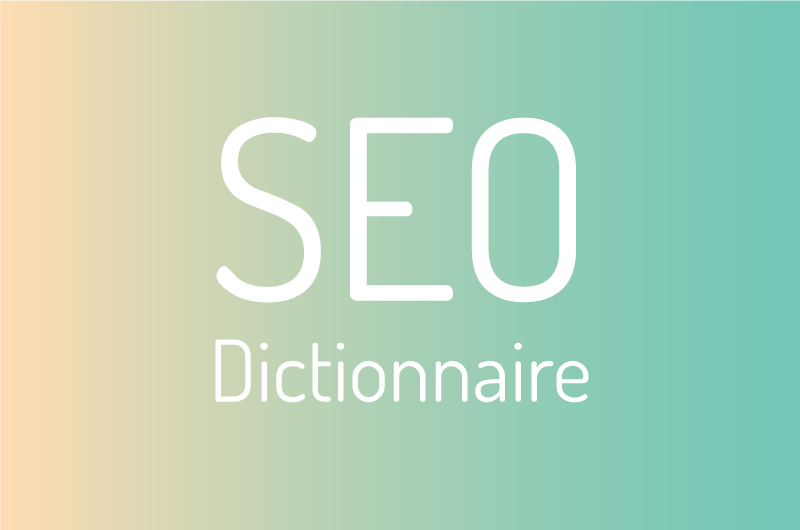Let’s face it, with 93% of online experiences start with a search engineit is important to become familiar with these platforms. To do so, it is important to understand how search engines work and to master the different processes that will allow you to position yourself correctly in their results. All these practices are called SEO for Search Engine Optimization. It is a very vast discipline with a very rich and vast vocabulary. Indeed, whether you like it or not, if your ambition is to increase the visibility of your website, you will inevitably be confronted with the use of SEO which will regularly lead you to be confronted with terms that can sometimes be difficult to understand, especially if you are a novice in the field. For this reason, I have established this glossary that includes definitions and explanations of words and phrases that are used in that are used in the context of SEO. Since SEO is an internationally practiced field, you will regularly find terms in English that are now widely used, so we have kept them as they are.
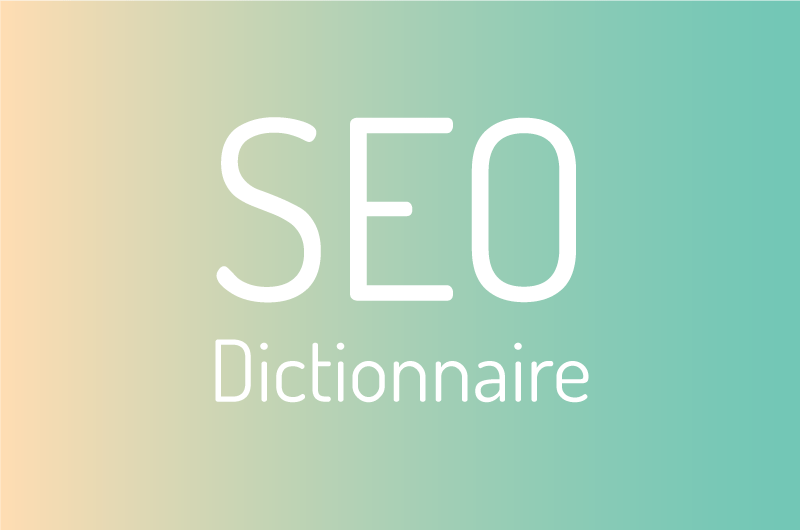
Navigate more easily in this SEO dictionary by clicking on the first letter of the word whose definition you want to find:
A
Above the Fold
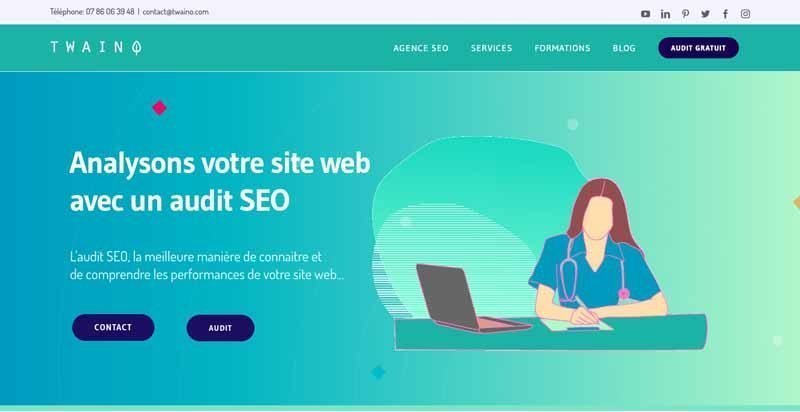
Above the Fold is a term that literally means “Above the fold”. Indeed, it is the content that automatically appears on a website before the user scrolls down.
It usually includes the navigation menu and the Slider. At this level, keep in mind that Google created the layout algorithm in 2012 so that sites with too many ads in this space are less well referenced.
Manual action
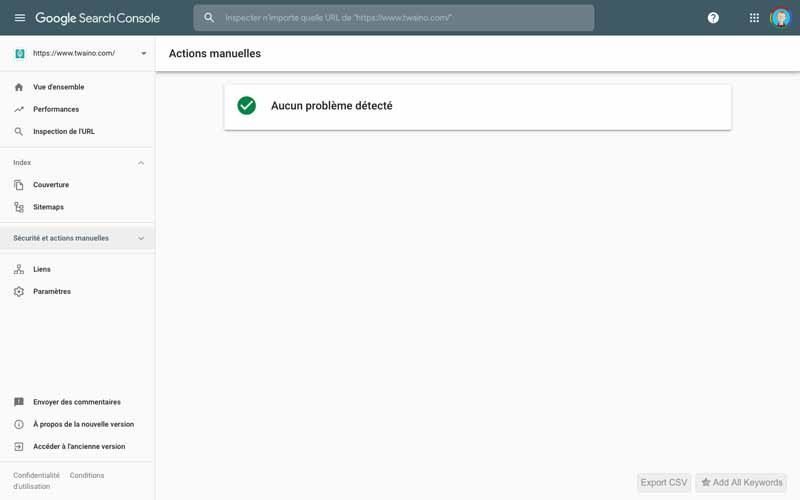
A manual action is a penalty imposed on a website when it does not respect the guidelines of Google guidelines related to quality. It is usually determined by Google’s team and results in a demotion or even removal of the website’s pages in the search results.
Manual action can occur if there is :
- User-generated spam;
- Artificial links to your site;
- Artificial links on your site;
- Deceptive redirects or cloaking techniques;
- Free hosts associated with spam;
- Structured markup containing spam;
- Aggressive spam;
- Hidden images: Cloaking;
- Etc..
To find out if you are subject to manual action, Google says ” we’ll let you know in the manual action report and in the Search Console message center “. So it’s very important to set up the Google Search Console account of your website so that you don’t miss out on being notified of any manual action.
Accelerated Mobile Pages or AMP
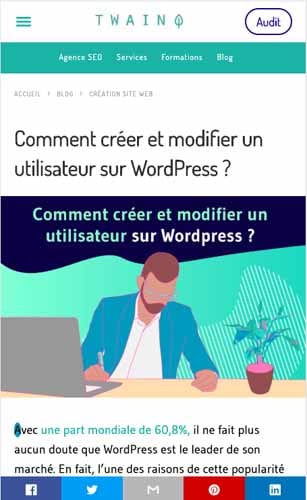
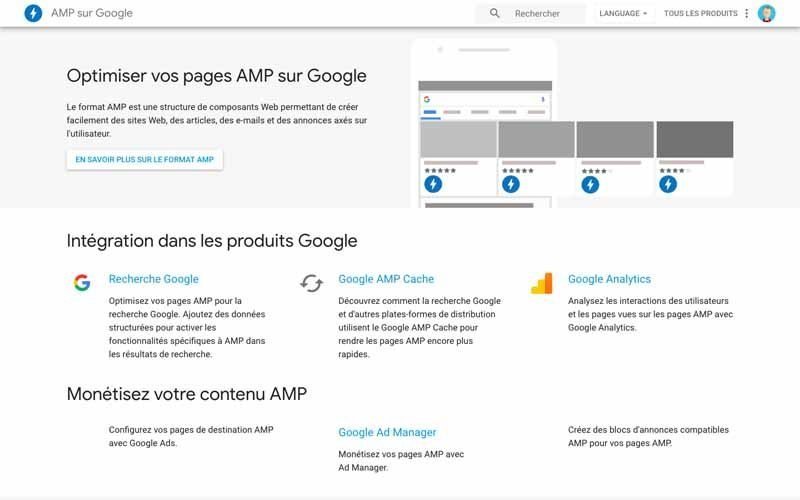
Accelerated Mobile Pages or AMP is an open source project launched by Google in February 2016. It aims to improve the performance of web pages for mobile devices.
This technology is already used by a large number of sites including:
- ABC;
- CNN;
- Fox News ;
- Le Parisien;
- The Washington Post ;
- Etc..
In fact, the senior product manager of The Washington Post, David Merrellsays, ” We’re committed to speeding things up in every area. If our site takes a long time to load, no matter how good our journalism is, some people will leave the page before they see what’s there. “.
So it would be wise for you to also look at theuse of AMP for your website. And if you have a website on wordpress, I’ll show you how to switch to AMP in a future article.
AJAX
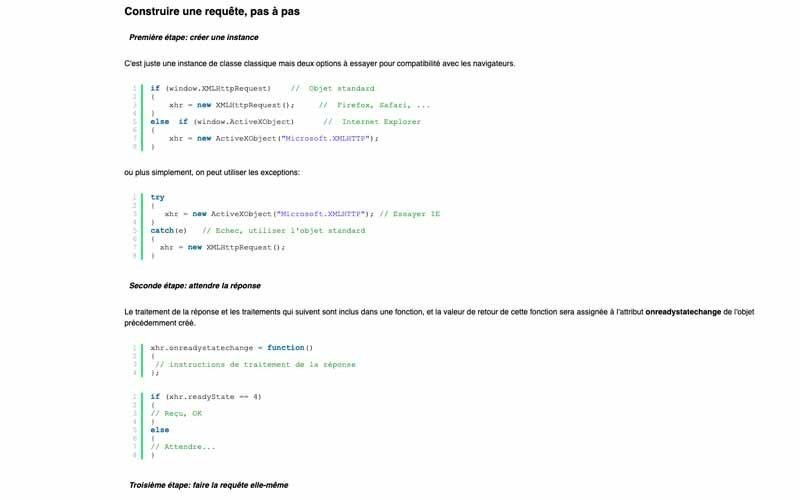
Asynchronous JavaScript and XML is a type of programming that allows a web page to send and receive data from a server in order to dynamically change the page without reloading.
Algorithm
In SEO, an algorithm is a complex computer program that search engines use to retrieve data in order to provide results for a given query.
It should be noted that search engines do not use a single algorithm, but a set of algorithms. This allows them to provide web pages ranked according to a number of factors via a results page.
Algorithm Change
Search engines are constantly changing their algorithms to improve them. While some changes go completely unnoticed, others designated as “major” have a major impact. Algorithm change comes in three forms:
- New Algorithm it means the addition of a new algorithm by the search engine in order to improve the quality of search. At Google, we have for example: Panda and Google Penguin.
- Algorithm Update algorithm Update: It refers to the modification of certain signals at the level of an existing algorithm, which significantly impacts the referencing. For example, the panda update affected 12% of all English queries ;
- Algorithm refresh this is the re-run of an existing algorithm with small changes that have almost no impact. Considering the same source, only 1% to 2% of all English queries were affected
Alt text / Alt Tag / Text Attribute
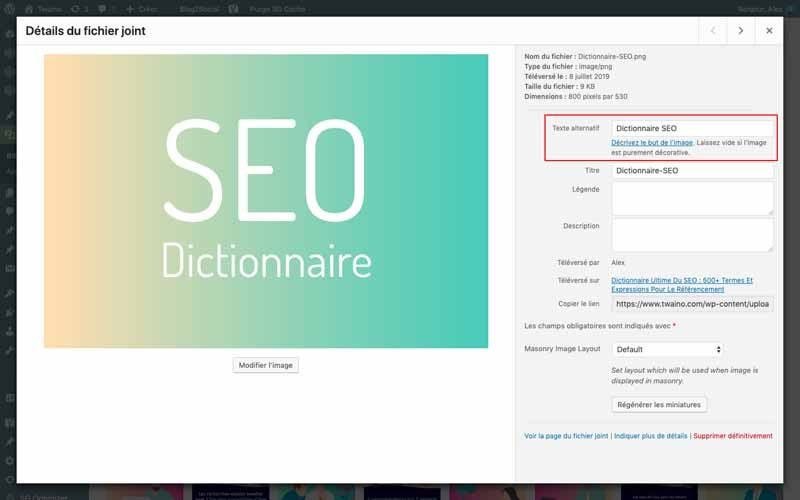
This is a short name for “Alternate Text” which designates a description of images for search engines. Indeed, search engines, especially Google, are not yet able to understand the content of images. However, they can read the “Alt text” tags in order to display relevant images in its results.
The next time you add images in your articles, remember to add the “Alt Text” tags.
Analytics
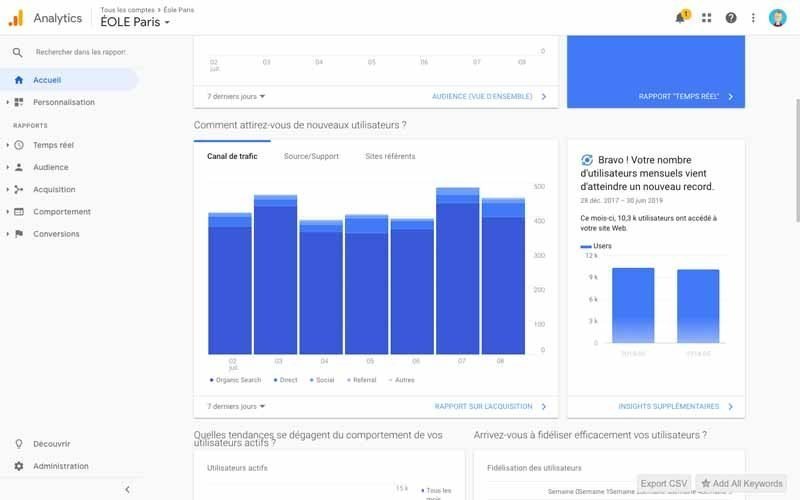
This is a software that allows you to easily analyze your website by collecting valuable information in order to take actions to improve your performance.
Among the powerful tools in this category, there are Google Analytics which allows you to have relevant information in real time.
Link anchor or anchor text
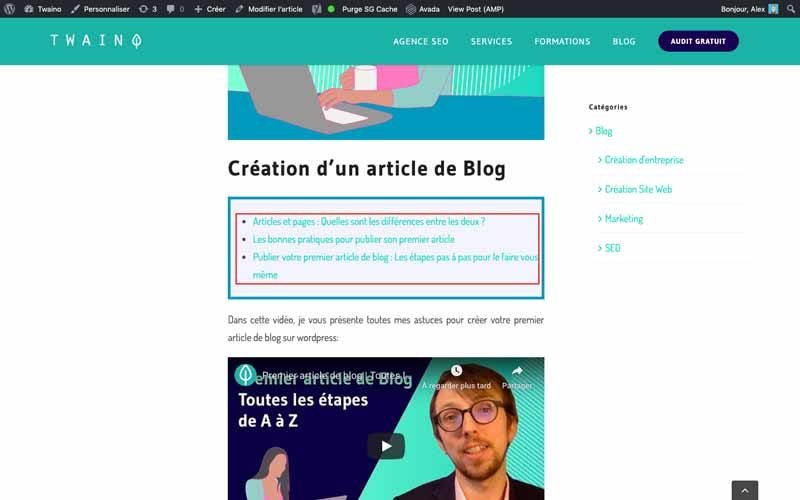
According to definitions-seo, ” A link anchor refers to the textual content of the link, which will appear by default in blue and underlined in a web browser. It is also called Anchor Text and most often indicates what the remote page is about. “
The use of link anchor is a very common practice, but note thatit is important to define it well so that it is natural and well interpreted by search engines.
For example, “definitions-seo” is the anchor that will take you directly to the web page containing the link anchor definition.
Allow
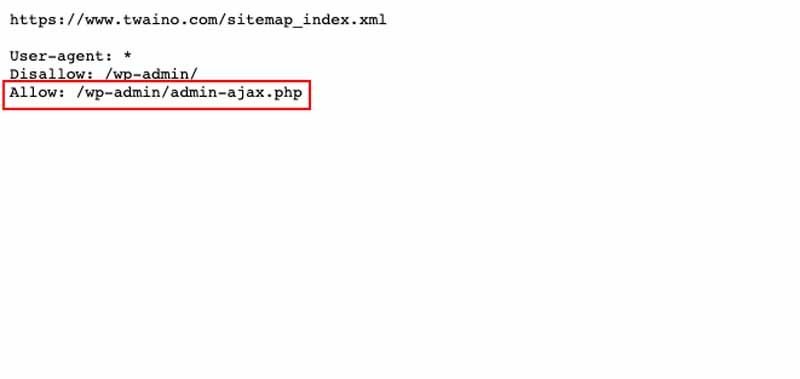
Search engines allow you to control the indexing of your website. Thus, you can allow or disallow the indexing of your website or pages of your website by search engine robots.
Therefore, “Allow” is the directive used in the robots.txt “file to allow crawling of your website, unlike “Disallow” which prohibits it.
App Store Optimization or ASO
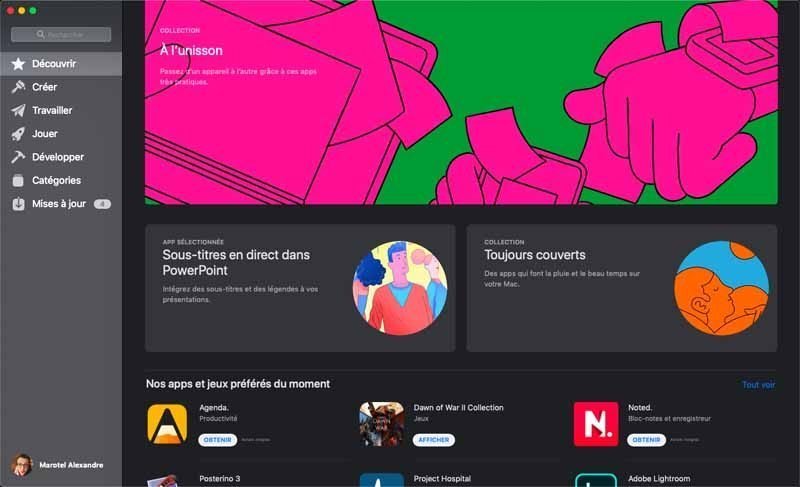
App Store Optimization or the acronym ASO refers to all the techniques implemented in order to improve the referencing of an application on the Internet mobile stores. It is for example Google’s PlayStore for the Android system and Apple’s App Store.
In fact, the Apple App Store has 2.2 million downloadable applications, while the Google Play Store has 2.8 million applications available. Taking into account these statistics, there is no doubt that it is essential to have a good strategy to make your application visible and popular.
To do this, you need to use ASO, whose principles differ from those of classic SEO. Here are some criteria according to thetool.io :
Authority
In SEO terms, authority refers to trust. When users find information relevant to their search, your website is credited with their trust. Your website can also gain authority if other websites are talking about you.
Authority Sites or Site of Authority
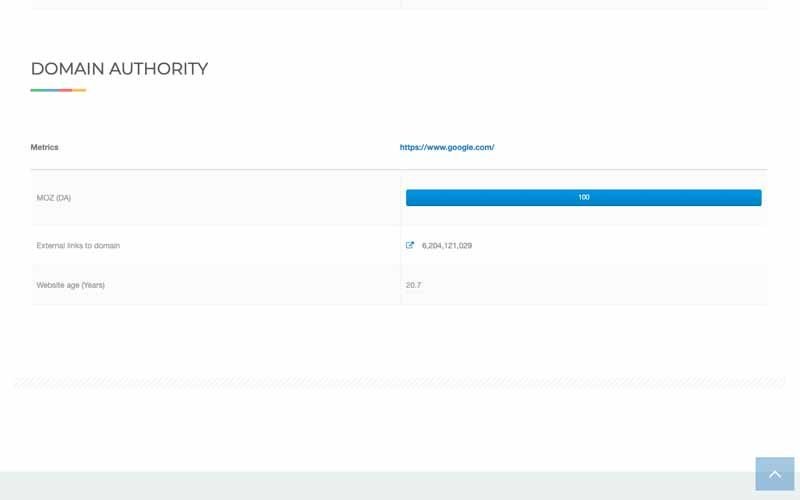
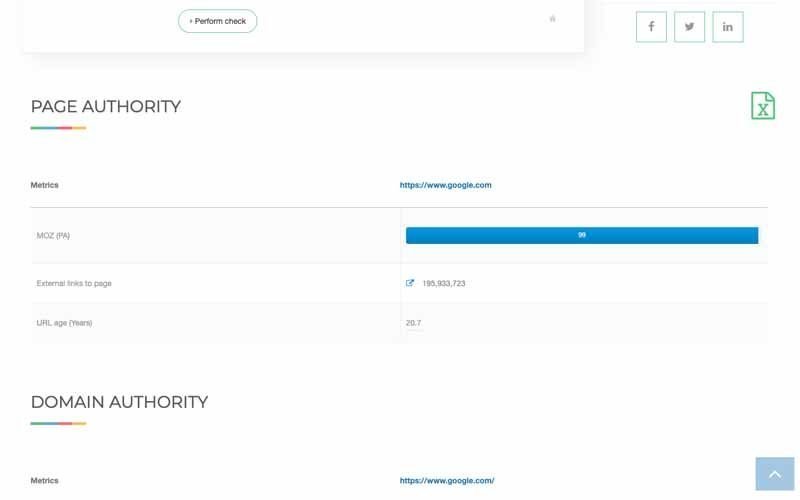
An authority site is a quality website that will be considered very trustworthy. When a website gets a lot of backlinks, it usually indicates that its content is of high quality and that readers already trust you.
However, be aware that building an authority site will take time to build. Indeed, one of the goals will be for you to get inbound links from other authority sites. The more authority your site has, the more likely Google will favor you in its rankings.
A typical example of an authority site is Neil Patel.
Autocompletion or automatic suggestion
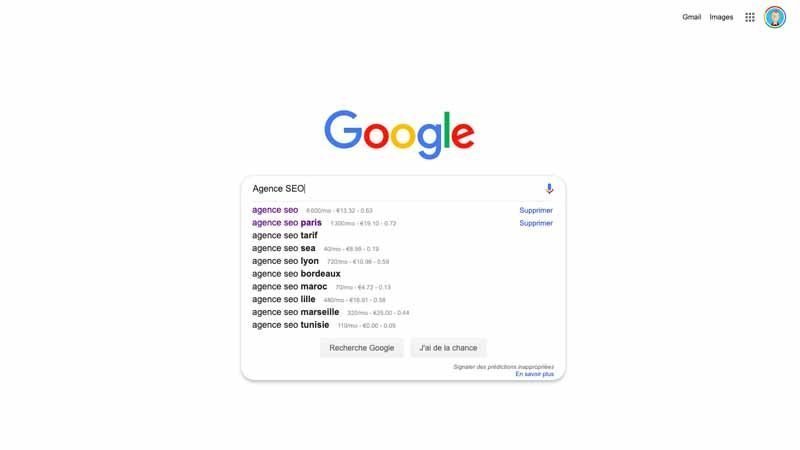
This is a function that allows search engines to automatically suggest queries as the user enters the search intent. In other words, this option limits the number of words or characters that you have to enter by suggesting a complement that could be suitable for the rest of your query.
This feature is made possible by Google Suggest launched in 2004 and Google Instant launched in 2010
B
Baidu
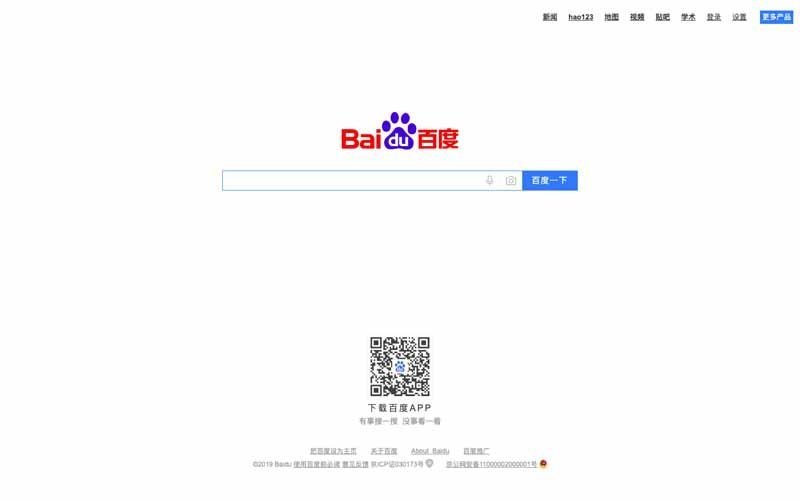
Founded in January 2000 by Robin Li and Eric Xu, Baidu is the most popular search engine in China with a share of 66.2% against 14.4% for Google.
Backlink or link back
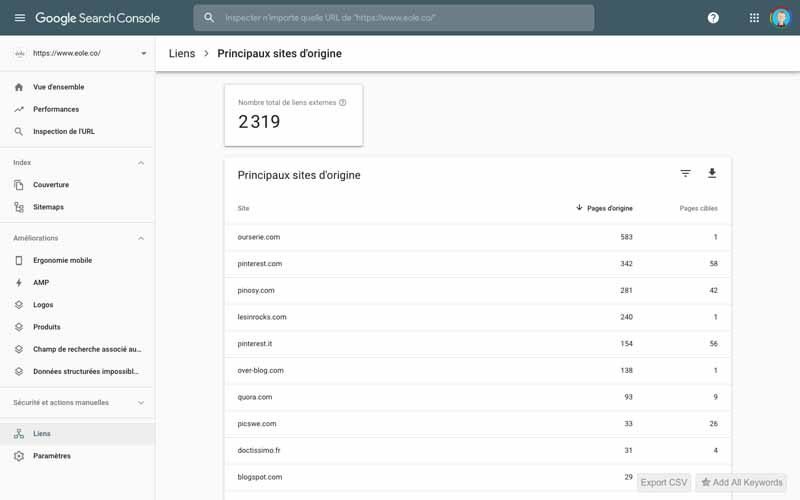
According to definitions-seo : ” A backlink is an incoming hyperlink, coming from another website. If a page A links to a page B (on another site), we say that A is a backlink from B or that B gets a backlink from A. “
Search engines, especially Google considers the backlink as a criterion in the referencing of websites. That said, the goal is not to have many backlinks from various sites, but to ensure that they are quality and come from relevant websites. To track your backlinks, a tool such as Google Search Console can help you to have a list of these links and their origin.
Canonical tag or Canonical URL
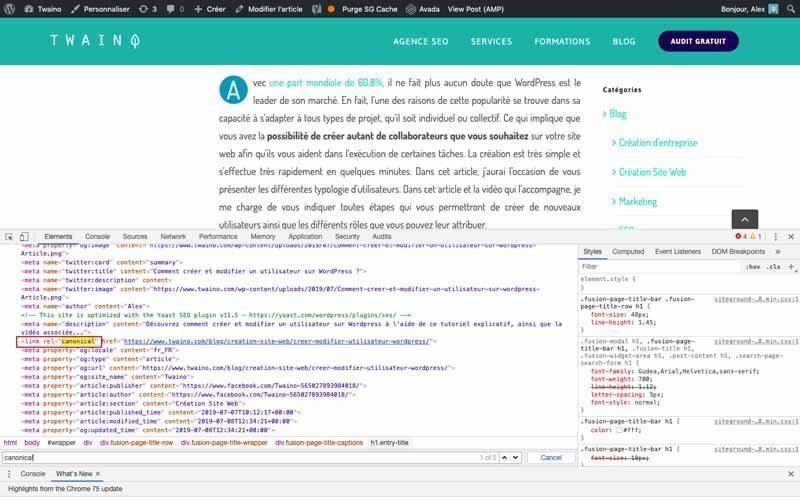
Designed by Google, Bing and Yahoo in 2009, the canonical tag allows to avoid the problem of duplicate content. Indeed, it indicates that a web page uses the same content as another web page.
For this, this tag includes the link of the original page which is called canonical and is presented in the form
Note that it is very important to use the canonical tag because Google considers that: ” If you don’t explicitly tell Google which URL is canonical, Google will choose the canonical page for you or consider all similar pages equal: this could lead to undesirable behavior…. “. This can negatively impact your SEO.
In addition, using canonical tags allows you to, among other things:
- Manage syndicated content;
- Define the URL you want to be displayed in search results;
- Group link indicators for similar or duplicate pages;
- Simplify tracking of statistics for a single product/topic;
- Etc..
Structured Data Tags or Rich Snippet
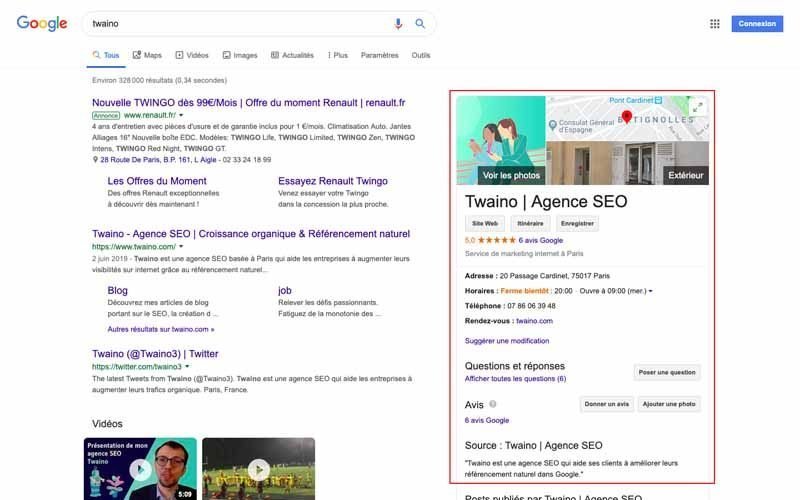
Structured data tags, also called Rich Snippet, allow search engines to better understand the content of a web page and to analyze it much more easily.
Indeed, these are semantic tags added to the HTML code of a web page in order to provide additional information on the content of the page in question. This sometimes allows search engines to add additional information in their search results.
As stated by Google that it: “ relies on structured data found on the Web to understand the content of the page, as well as to gather information about the Web and the world in general. ” and ” Google search also uses structured data to provide special features in search results and optimizations “.
So this is a very important element that I urge you to insert into your SEO strategy.
Pagination tags
Like most other tags, these help search engine robots to better index the content of web pages by indicating that the content is divided into several paginated parts and accessible with many clicks.
This concept was introduced by Google in September 2011 and allows you, for example, to optimize the indexing of the pages of a large product list.
Let’s take the example of Google let’s assume that you have 4 parts corresponding to the following URLs:
http://www.example.com/article?story=abc&page=1
http://www.example.com/article?story=abc&page=2
http://www.example.com/article?story=abc&page=3
http://www.example.com/article?story=abc&page=4
The first URL will have in the Head part of its source code a “rel=”next” tag indicating the URL of the next page :
The second URL will have a “rel=prev” tag with the URL of the previous page and a “rel=next” tag with the URL of the next page:
And so on until the fourth (and last) URL which will have a “rel=prev” tag with the URL of the previous page:
To go further on the subject, you can consult this article from webrankinfo.
Hreflang tags
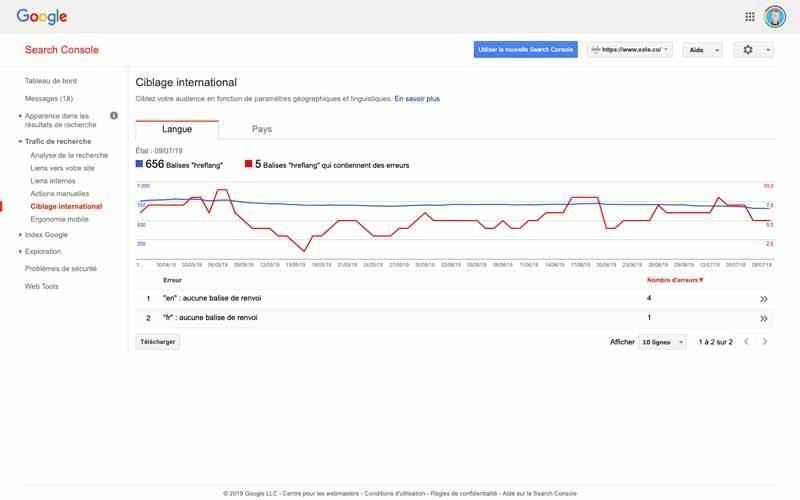
Proposed by Google since 2011, the Hreflang tags allow you to indicate the language of the page and the target country for which the page is intended. This tag can particularly help you if the content of your pages are translated into several languages.
However, Google indicates that: ” even if you choose not to use this feature, different language versions of your page can be detected by Google. However, it’s usually best to explicitly tell us which pages are specific to the languages or regions you cover. “
Using the example of abundance, the tags will look like this:
” For 4 websites targeted to different languages and/or countries:
http://www.example.com/: general home page in Spanish.
http://es-es.example.com/: Spanish home page, for Spain.
http://es-mx.example.com/ : homepage in Spanish, for Mexico.
http://en.example.com/: English home page.
The following tags can then be integrated into each site respectively:
. “
Meta tag
According to definitions-seodefinitions, a meta tag is: ” an HTML tag found in the HEAD part of a page’s source code that provides meta-data to the browser, i.e. information about the page in question. Meta tags are normally invisible in the user’s browser “.
Meta tags are usually presented in the following way:. In addition, there are several types of meta tags including :
- The meta description tag ;
- The meta robots tag
- Etc..
Note that Google does not accept all meta tags and if you want to familiarize yourself with this type of tag, this article from Google will allow you to know which ones are accepted.
Description meta tag
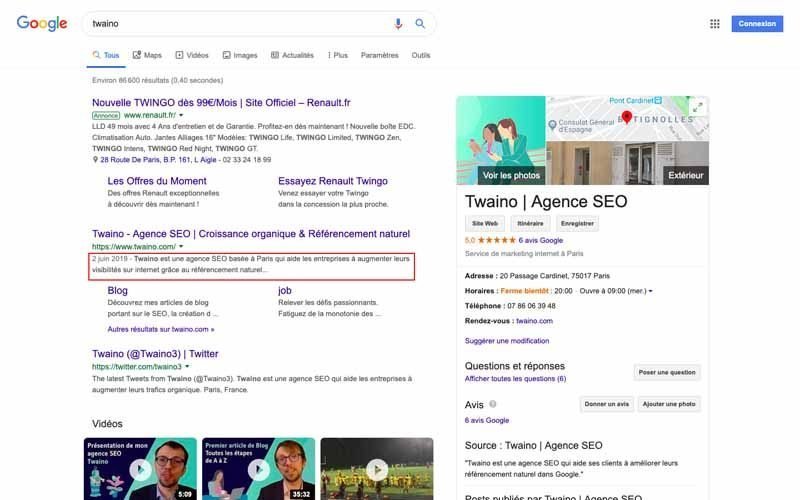
This is a very important meta tag that provides a summary of the content of a web page to search engines so that they can display it in their search results.
Although it is not a criterion to be ranked higher, it can improve the click rate if it is catchy enough.
It is presented in the form of and includes about 155 characters maximum with Google.
However, the firm estimates in its article on how to creating quality titles and excerpts that: ” There is no limit to the length of meta descriptions, but snippets in search results are truncated as needed, usually to fit the width of the device. ”
Meta Robots tag
This meta tag is used to give indications to search engine robots regarding the consideration of a web page. For example, it tells them if they should index a page or not.
It is generally presented in the form :and you can discover how to use it on this resource of contentking. Afterwards, you can also learn about theimpact of this tag in Google search results.
Meta Keywords tag
This is a tag to indicate the keywords that describe the content of a web page to search engines. But as a reminder, Google has declared that it does not take into account the meta keywords tagtag, so this tag has become obsolete.
Title tag
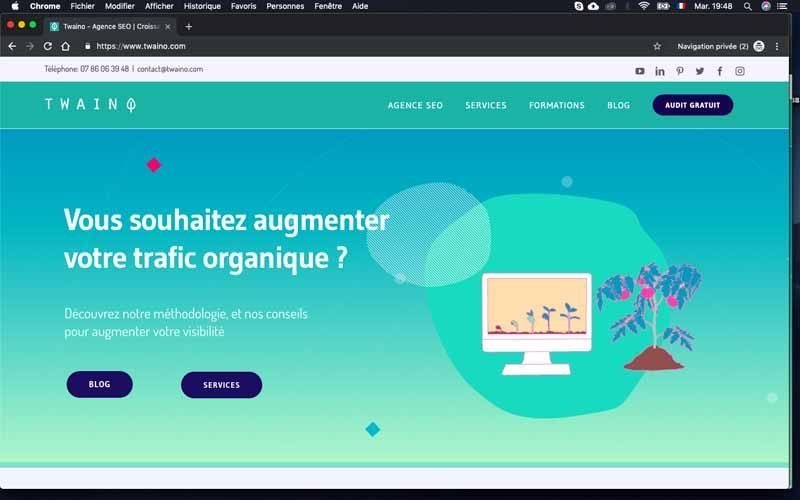
The title tag corresponds to the title of a web page and is usually presented in the search engine results and in the title bar of the browser. This layout makes it one of the most important tags in terms of SEO and I invite you to optimize your title tags correctly to improve your ranking in search engine results.
It is presented in the form of a 512 pixels limit, which is about 55 characters. The guidelines from Google guidelines can also help you significantly optimize your title tags.
Bing
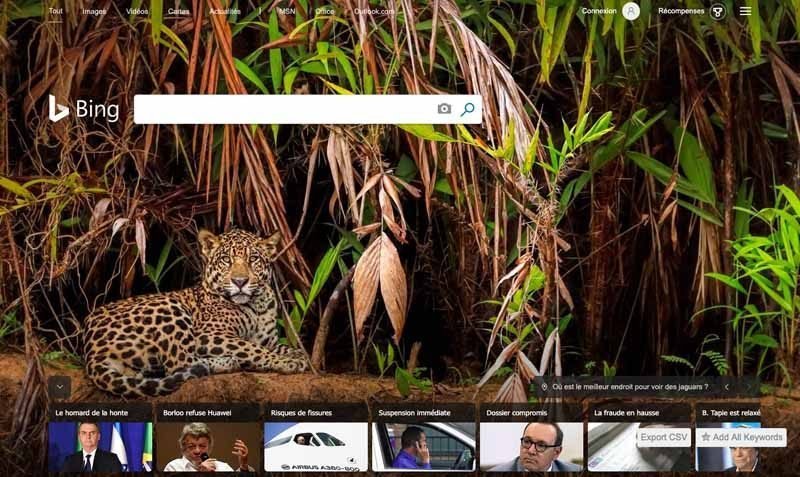
Launched in June 2009, Bing is the third largest search engine in April 2019, after Google and Yahoo, with a global market share of 3.13%. This search engine was designed and launched by Microsoft and replaces the former Microsoft Live Search and MSN Search.
Bingbot
All search engines have bots that allow them to explore the web in order to perform the indexing of web pages, Bingbot is the name of the robot of the Microsoft search engine, Bing.
Black Box
In French Black Box, the Black Box is a complex computer program whose inputs and outputs can be observed, but whose internal process is not accessible due to its confidential nature. For example, google’s algorithm is a Black Box since we can only see the queries (inputs) and the results (outputs) without knowing how the algorithm works.
Black Hat
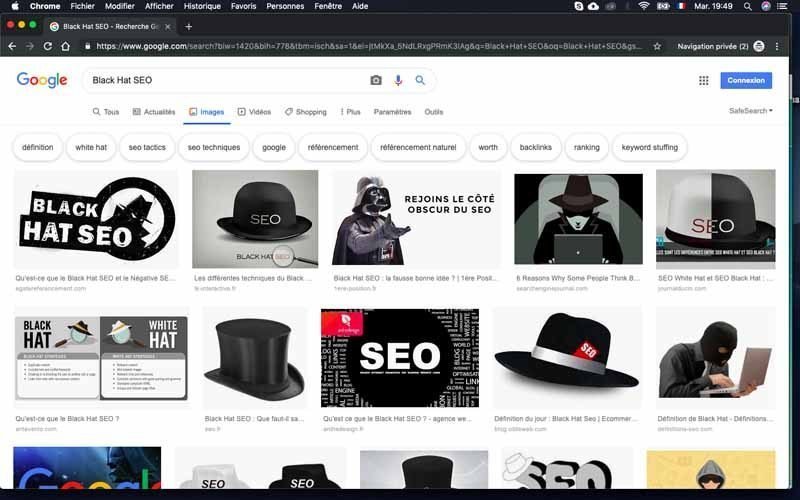
Google, the most popular search engine in the world, has put in place guidelines for webmasters that they must respect. However, some SEOs do not follow these recommendations by using illegal practices to manipulate the search engine algorithm in order to rank higher in the results.
Google indicates that these practices are: ” likely to result in the application of a manual action for spam, an algorithmic penalty or the permanent removal of the site concerned from the Google index. “.
SEOs who do not respect the rules imposed by Google are called Black Hat SEOs and those who scrupulously follow the recommendations are White Hat SEOs. If you want to have more information on the subject, this seo resource resource will be of great help to you.
Blog
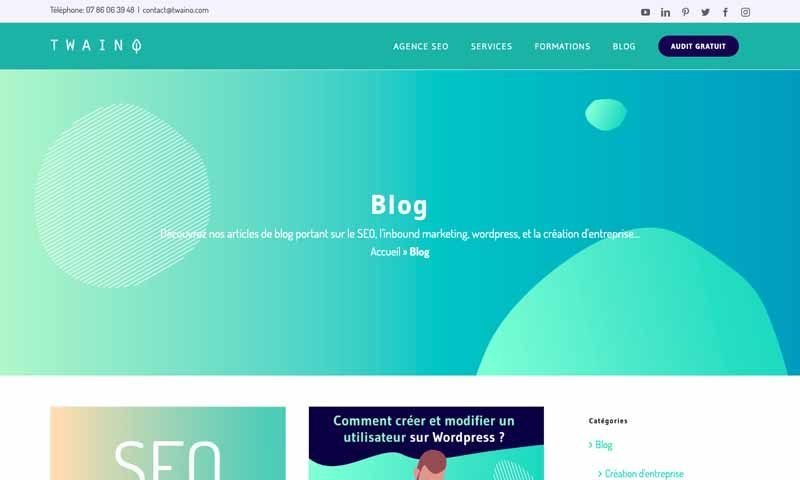
The blog or sometimes blog in Frenchis a type of website or a part of a website dedicated to the periodic publication of content sorted by order, from the most recent to the oldest.
The topics covered can reflect personal or corporate interests and can also be written by one or more people.
Originally, blogs were called “Web logs” or “Weblogs”. But since server log files were also called “Web logs”, this brought confusion and the abbreviation “blog” was created, becoming the most popular term.
Having a blog and being consistent in creating content is a very relevant practice in terms of SEO. Indeed, HubSpo states that ” 55% of marketers indicate that blogging is their top priority “. So it’s a very effective tactic if you use it correctly.
Bounce Rate
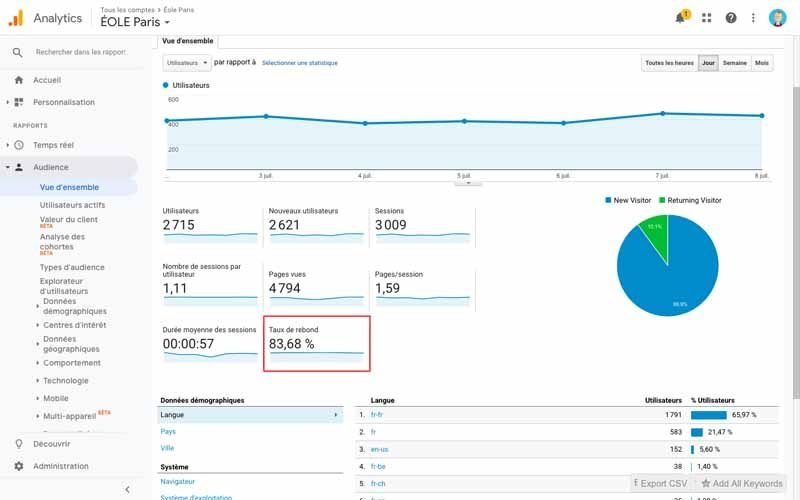
The bounce rate or bounce ratethe bounce rate is the proportion of visitors to a website who leave without having visited another page apart from the one they consulted. This rate varies according to several factors including :
- Poor quality content ;
- A suffocating layout;
- A page that takes too long to load;
- A lack of call to action;
- The dissatisfaction of visitors due to poor targeting;
- Etc..
Generally, there is a bounce when the visitor has :
- Typed a new URL;
- Clicked on an external link;
- Closed the tab or window;
- Clicked on ” Back ” in his browser and left the site;
- Etc..
However, it can also mean that users immediately found what they were looking for. If your website is used to provide the time, for example, visitors will not need to go further in their search.
Hubspot offers some interesting tips to analyze and limit the bounce rate.
Budget Crawl or crawl budget
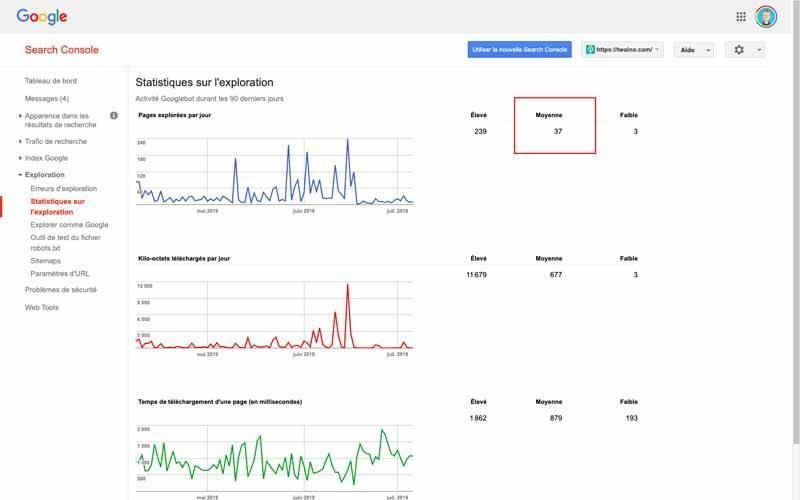
According to definitions-seothe crawl budget represents: ” the limits in terms of number of pages that Googlebot (Google’s robot) will crawl on a website taking into account several criteria: size of the site, crawling speed, frequency of updates, content quality and number of clicks.“
Nevertheless, Google indicates in a post that ” if a site has less than a few thousand URLs, it will be crawled correctly most of the time “. This means that you don’t have to worry if you have a website with only a few pages, but it’s always useful to think about optimize your crawl budget in order to improve the indexing of your pages
C
Google cache
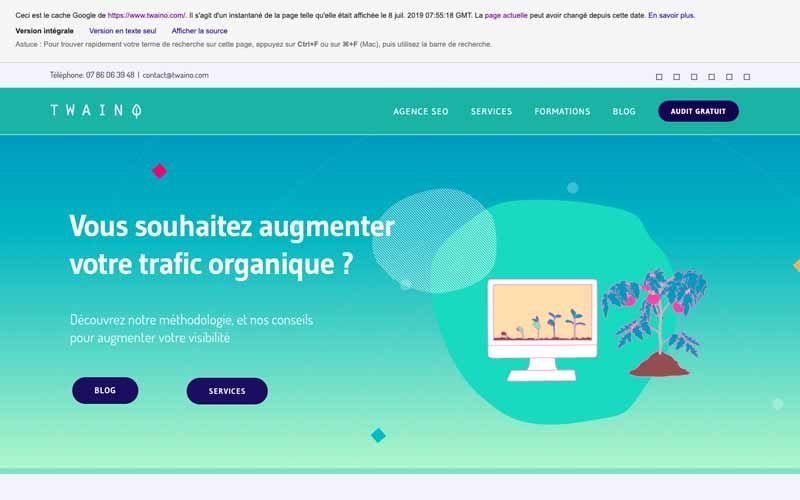
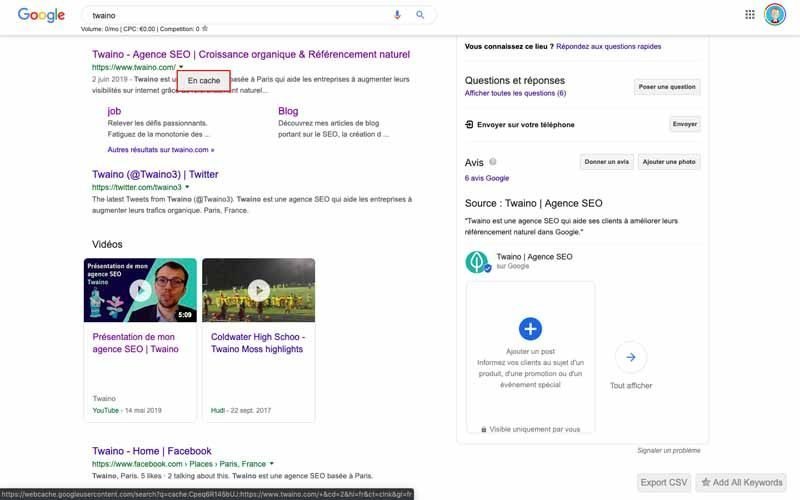
This is the version of a web page that the search engine holds and shows in its results. This version is not necessarily the one that is available at a given time on the web page.
Indeed, Google tries to have the most recent version possible of the various pages it indexes through its robot. But as long as the latter does not return on a web page to crawl again, it may happen, especially if the page has been modified, that this page is different from the one known by Google.
There are different solutions to look at the Google Cache of your web pages and this post from Google will allow you to do it.
Caffeine
Launched in 2010 by Google, Caffeine is a program that renewed the old indexing system of the search engine with a new structure more robust and fast. The objective of this renewal was tobe in phase with the evolution of the web at the time and therefore to meet the requirements of the web.
Camel Case
Camel Case or literally camel case in French, is a practice that consists in writing an expression by putting the initial of each term that composes it in capital letter. In SEO, this practice aims to make web page titles more visible in search engine results.
MasterCard, PlayStation or QuickTime are examples when talking about Camel Case.
Cloaking
This is a violation of Google’s guidelines guidelines by displaying different content or URLs to people and search engines. In SEO, this practice allows to send a given page to a human visitor while sending another one to the search engine.
The goal is always to rank higher in the search engine results. The cloaking is declined in several techniques including :
- Cloaking based on the user-agent;
- IP Delivery” cloaking based on the IP address
- Cloaking via Javascript, Flash or Dhtml;
- Cloaking of the text or the invisible block;
- Etc..
Clustering
According to definitions-seo : ” Clustering, in the field of information retrieval, refers primarily to two things: on the one hand, the fact that engines arrange a site or a web page in different “clusters” (themes): sports, politics, e-commerce, etc. And on the other hand, the fact of limiting in their SERPs the number of links for a single website. “.
This definition indicates that the term Clustering can be used to designate two different procedures at the search engine level. The first concerns the categorization of a web page, a website … in a specific theme. This implies that a page can be compartmentalized in several clusters.
The second procedure concerns the limitation of the number of links per website in the search results. Indeed, Google already applies its diversity policy in the search results by limiting the number of links per website to only two. However, this number can vary depending on the queries.
Semantic cocoon
Inspired by siloing, the semantic cocoon was introduced by Laurent Bourrelly and is based on a semantic analysis of the visitor’s needs in order to design a relevant website architecture. This is a mix of internal meshing and content optimization
In practice, the semantic cocoon allows to push a target page thanks to other pages of lower level with a relevant internal netlinking system. The semantic cocoon has a positive impact on natural referencing and it would be wise to take an interest in this technique to create your your own semantic cocoon.
SEO Contest
As the name suggests, this is a competition between SEOs who must rank on a defined expression over a given period. The SEO who comes out on top at the end of the agreed period wins the competition. The rules can vary and are sometimes very strict. For example, the nextlevel contest contest in 2019 based on the keyword “foldable phone”.
Content Spinning
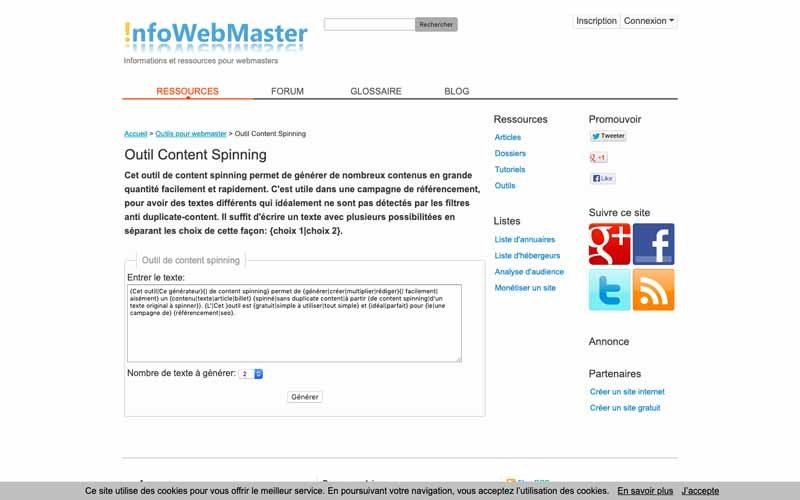
Content spinning or spinning is a practice which aims, in a technical way, to create texts from an original text thanks to a software. Indeed, content spinning is used in SEO because it allows to create content quickly, and to avoid duplicate content problems through the use of words and expressions that are somehow synonymous.
Using the example of redacteur.comwe have :
The text ” This car is the fastest and most comfortable on the market. In addition, its price defies all competition. “
Which becomes with a spinning software: ” {This car} is the {fastest|powerful|efficient} and most {comfortable|luxurious} {on the market|in its class}. Plus, its price {is unbeatable|is very affordable|is very reasonable}. “.
From this, we can have sentences such as:
” This sedan is the best performing and most comfortable in its class. In addition, its price is very affordable. “
” This car is the most powerful and luxurious in its class. Moreover, its price defies all competition. “
This method seems very economical in terms of time, but Google considers content sipinning as spamhowever, Google considers content sipinning as spam, which could harm your SEO if you don’t know how to use this practice properly.
Crawl
The crawl refers to the action of search engine robots to explore a website to know all the pages of the site. This action is carried out thanks to the links proposed on these various pages and it depends on several factors as indicated by Google : ” Our computer programs determine which sites to crawl, how often to crawl them, and how many pages to crawl for each site “.
Crawler or robot
A robot is a program used by search engines to collect data from the Internet. When a crawler visits a Web site, it selects all of the Web site’s content and stores it in a database. It also stores all the external and internal links of the website and will visit them at a later time, this is how it moves from one website to another
D
Datacenter or data center
In SEO, a datacenter is a place exclusively reserved for the storage of the infrastructure and the index of search engines, which allow it to provide its services. As for Google, it had 34 datacenters spread around the world in 2008.
The American firm gives moreinformation on its datacenters by revealing some addresses as well as their description with images.
Request for review
When a website is subject to manual action or security problems, the request for reconsideration or consideration is a step that allows it to end the penalty or security issue. Indeed, the site submits this request to the Google Search Quality Team after correcting the errors and mistakes found by the firm.
This request is made in the form of a form to fill out and the team judges whether the corrections made are sufficient or not. If the corrections were made correctly, then the problem is solved or the penalty is cancelled. But if not, the corrections must be made again and a request for reconsideration must be submitted.
The reconsideration process is usually lengthy as it can take 1-3 weeks for a request to be answered, so it’s wise not to be subject to a penalty.
Keyword density
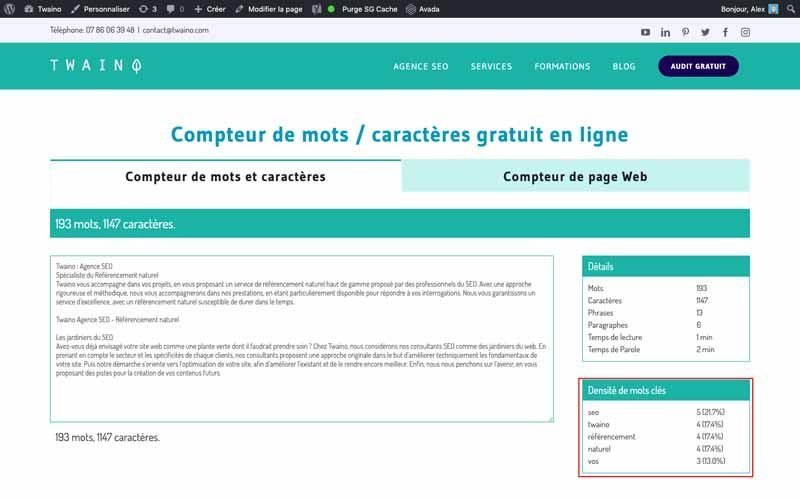
The density of keywords is the proportion of the number of appearances of a word compared to the total number of words in the text. Indeed, the use of keywords is a very important practice in SEO that was born in the 2000s. It consists of repeating keywords a certain number of times in order to be better ranked in the search engine results.
That said, even if a repetition of certain keywords can allow the search engine to understand the theme of the content, working on the density of keywords seems not to be very effective according to Matt Cutts.
If you want to test your keyword density you can use our word counter.
Link disavowal
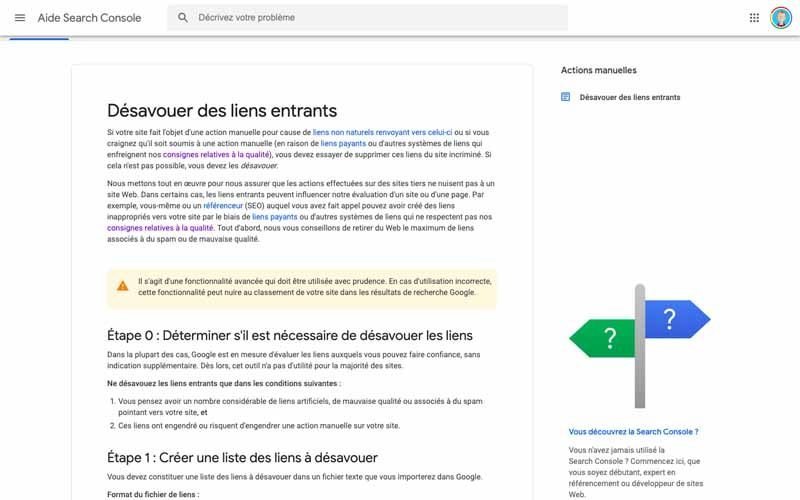
When you consider that some links entering your website are ”toxic” or come from websites that do not respect the guidelines of Googleyou can tell the search engine to no longer consider these links in its analysis.
Indeed, your website may be penalized if Google considers that it receives too many artificial inbound links. It is therefore in your interest to disavow these links to avoid being penalized.
However, you should be very careful because Google considers that this is ” an advanced feature that should be used with caution. If used improperly, this feature can harm your site’s ranking in Google search results. “.
It is therefore important to understand all the issues of link disavowal and to do it correctly.
Deindexing
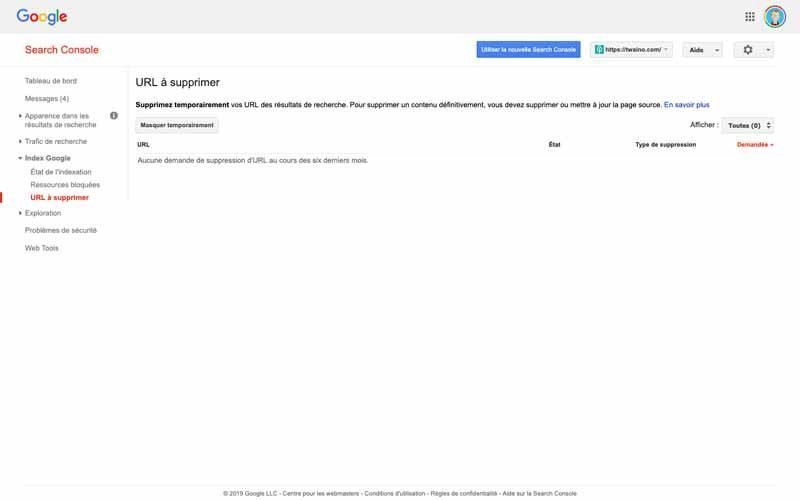
De-indexing is an SEO practice that consists in indicating to search engines the contents that should not be considered. It can be low quality content or content that you want to keep private so that it does not appear in search engine results. We distinguish for example:
- Pages with duplicate content;
- Pages imported from a demo theme;
- Pages with spun content;
- The pages of the internal engine results;
- Etc..
The de-indexation allows you to sort and offer the most qualitative contents to the Internet users. To carry out the de-indexation, you have several options including :
- L’the use of the meta robots tag “noindex ;
- The robots.txt file ;
- The URL deletion form in the Search Console ;
- Etc..
Disallow
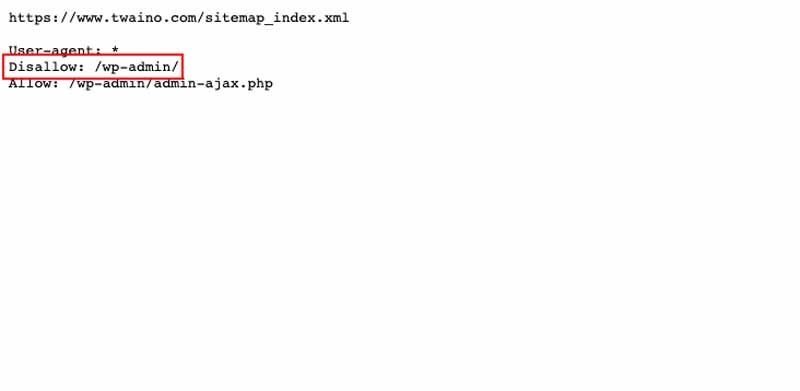
Disallow is a directive that allows you to tell search engine robots not to crawl a page or a website. In other words, you can use it to make sure that Googlebot does not go to certain areas of your website.
The Disallow directive is set in the robots.txt file with the following syntax:
Disallow: [path], with [path] as the beginning of the URL of the page not to be crawled. Using the example of definitions-seoexample, we have :
” For a site of type https://www.exemple.com/ :
Disallow:
No restrictions. Free access.
Disallow: /
The site is completely forbidden to explore.
Disallow: blog
No page whose URL starts with “blog” will be crawled (example: https://www.exemple.com/blog or https://www.exemple.com/blog/exemple.php).
Disallow: /*.pdf
No document with a URL containing “.pdf” will be crawled (example: https://www.exemple.com/contrat.pdf or https://www.exemple.com/blog/document.pdf or https://www.exemple.com/blog/document.pdf?langue=fr). “
However, note that this directive does not prevent the indexing of web pages, which induces the messages ” No information is available for this page “which appear in search results.
Dofollow
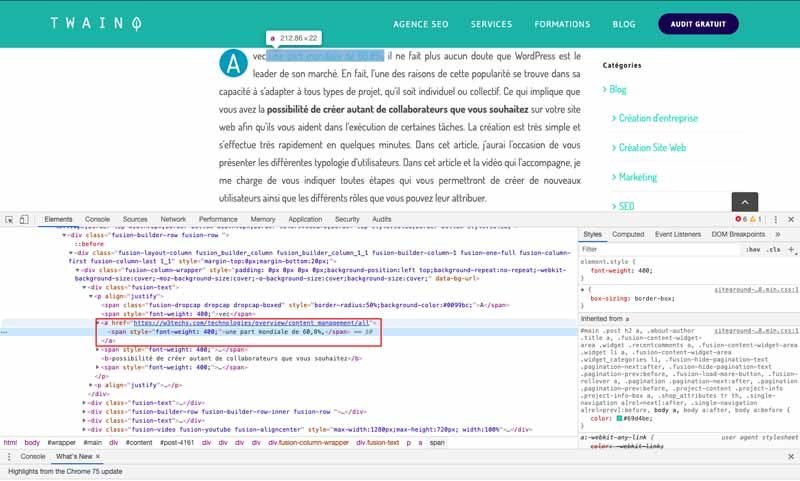
A dofollow link is a normal link that points to a web page indicating that it is useful and should be taken into account, thus increasing its value in the eyes of search engines. It is the opposite of nofollow which tells search engines to ignore the link.
Dofollow is used when:
- The website is legitimate and trustworthy;
- The site is useful for your readers;
- The website provides accurate information;
- The website is relevant to your content;
- Etc..
In fact, the dofollow indicates that there is no restriction with the nofollow, therefore, it is the classic link like: Link text.
In the case where it is used in a meta robots tag, this attribute tells search engines to take into account all the links coming from the page and is usually in the form :or.
To go further on the subject, you can consult seopressorwhich tells you more about the subject.
DuckDuckGo
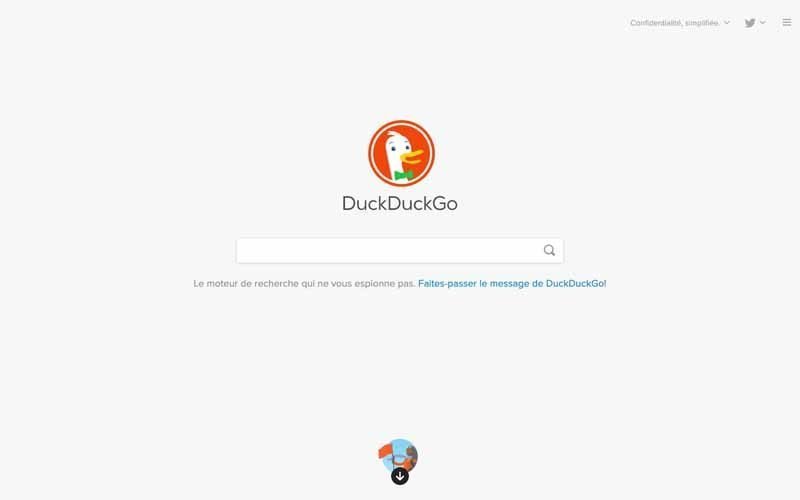
Launched in 2008 in the United States, DuckDuckGo is a meta-search engine that draws its data from several generalist search engines such as Google, Yahoo, Bing, etc… Its philosophy according to Wikipedia is to: ” preserve privacy and not store any personal information about users (IP addresses and digital traces such as the browser signature). “. So you can use it if you want your data to be protected.
Also, DuckDuckGo offers a feature that allows you to specify the source of the information. These are the shortcuts:
- !wfr for Wikipedia;
- !g ;
- Etc..
Duplicate Content
Still called duplicate content, this is a particularly important concept in terms of SEO. Google states ” Duplicate content generally refers to large blocks of content, belonging to the same domain or spread across multiple domains, that are the same or substantially similar.“.
Although duplicate content does not usually generate a direct penalty from Google, your page’s SEO or visibility may be impacted. Indeed, Google wants to offer users distinct information in order to be as complete as possible. To do so, it tries not to propose identical contents by privileging the original version to the detriment of duplicated versions.
But in case Google judges that you are using duplicate content to manipulate the ranking in its engines, your website can be ” permanently removed from the Google index, in which case it will no longer appear in search results. “. The same resource from Google tells you some practices to observe to solve the problem of duplicate content.
DUST
DUST or Duplicate URL Same Text is another aspect of duplicate content and occurs when a single page with a single source code can be accessed via different links. To this extent, search engines may believe that there are several pages and consider that there is duplicate content.
For example for the page: https://www.example.com/, there may be these URLs pointing to it:
- https://example.com/ ;
- http://www.example.com/ ;
- https://www.example.com ;
- https://www.example.com/index.php.
In this example, we have a total of 4 different URLs for the same page and as Google bases itself on the URLs to identify the pages, it considers that they are 4 different pages. From there, as the content does not differ, it will detect duplicate content on your website, which could penalize you. For this, you can use the canonical tag.
E
Exact Match Domain
In order to be better referenced in search engines, SEOs use several methods, including including the inclusion of keywords representing the main theme of the website in the domain name. The resulting domain name is the Exact Match Domain or simply EMD
For example, formation-redaction-web.com or restaurant-lyon.fr/ are distinguished as EMD.
Although this practice seems to be very advantageous, Google has decreased the influence of EMDs on its ranking since 2010. Nevertheless, it is important not to deprive yourself and and make sure to correctly define its Exact Match Domain.
F
Favorites or Bookmark
The bookmark is a good sign that a user has saved your website or a link to your site in his browser to come back to it soon in a much faster way. This means that they liked the content of this link and would like to use it later.
Featured Snippet
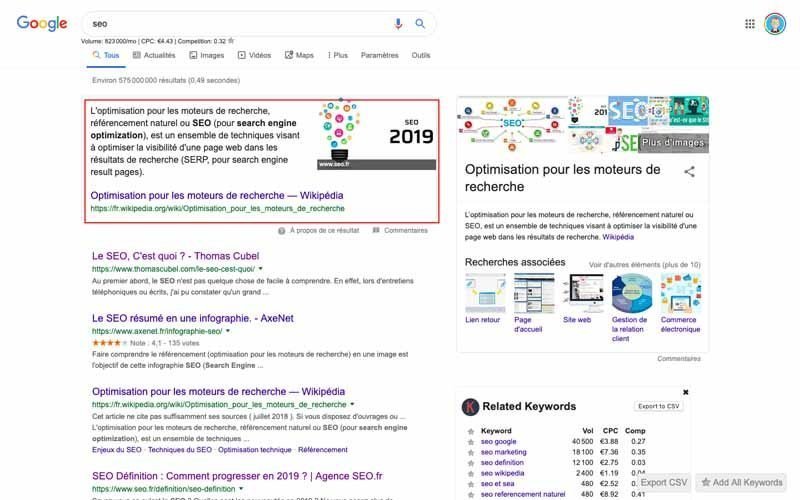
Also known as “position 0” oroptimized snippet according to Googlefeatured snippet is a feature that allows Google to display a direct response to a query without the user having to click on a link. It is a brief preview that Google usually shows when it deems the answer relevant, the user can then click on the link to get much more information.
The featured snippets are in the form of a text box located above the results and are sometimes accompanied by an image, it is a privileged position to increase your visibility.
When asked how to display an optimized excerpt of its page, Google says: ” This is not possible. Google’s systems determine whether a page can be an optimized snippet based on a user’s search query and, if so, select it. “. That said, there are practices that will allow you to optimize your content to show up in feature snippets.
However, note that Google does not display some content as featured snippet, it is the content :
- Sexually explicit;
- Inciting hatred;
- Violent and dangerous;
- Etc..
G
Geotargeting
Known in French under the expression Geographic Targetinggeotargeting is a technique for targeting users based on their geographical location. This is usually done when you want to display different content or ads to your visitors based on their location.
According to Google75% of consumers prefer ads that are personalized based on their location. The geotargeting is therefore a very relevant method that should be adopted.
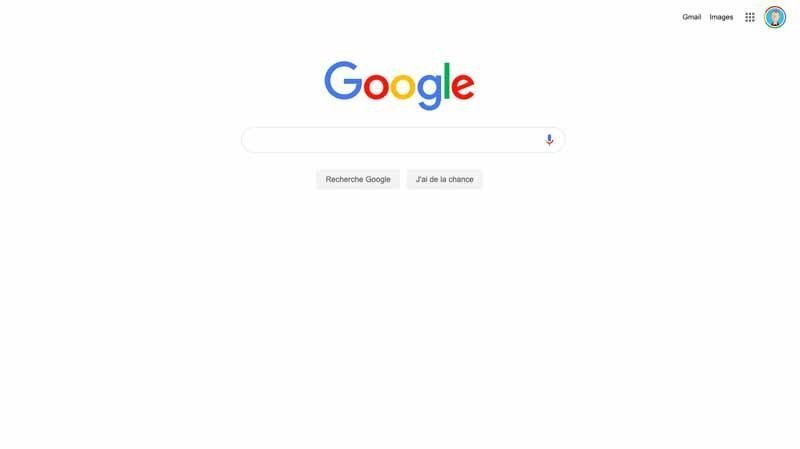
Google is the most popular search engine in the world with 94,2% of the world market share. It has been the undisputed leader in its field for several years and this position is reinforced by the many services and tools it offers. In terms of referencing, these are for example:
- Google+ ;
- Google Alerts ;
- Google Analytics ;
- Google Keyword Planner ;
- Google Maps ;
- Google Mobile-Friendly Test ;
- Google My Business ;
- Google PageSpeed Insights ;
- Google Search Console ;
- Google Trends ;
- YouTube ;
- Etc..
Google +
Google+ is the social network of the American firm launched in June 2011, both individuals and businesses. But Google now warns that: ” Google+ is only available for G Suite accounts provided by a company or school. The application is no longer compatible with personal accounts (usually ending with @gmail.com) since April 2, 2019. “
Therefore, its users are now companies and organizations that can create profiles, join communities….
Note that the content you publish there is immediately indexed, so it can be used as a referencing tool in the marketing of your company.
Google Ads
Google Ads is an online advertising service set up by Google where users position themselves on keywords so that their ads appear in Google and its advertising network.
Google has set up a complete guide on Google Ads that you can consult to know how to use it.
Google Alerts
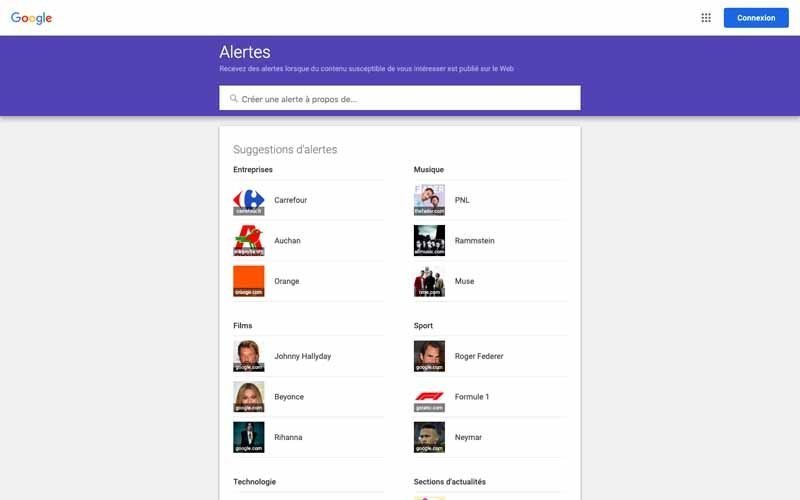
Google Alerts is a service developed by Google to notify content that may interest the user. Indeed, you can configure it to track different keywords and when content with these keywords is indexed, you will receive an email.
Some of the keywords you can track are:
- Your name;
- Your service;
- Your product;
- Your company name;
- Etc..
You can use it for reputation management, link building or to monitor your competitors and follow the evolution of their content. This google’s practical guide to Google Alerts can help you set up your alerts. To go further on the subject, Smartkeyword.io gives some tips for its use in SEO.
Google Analytics
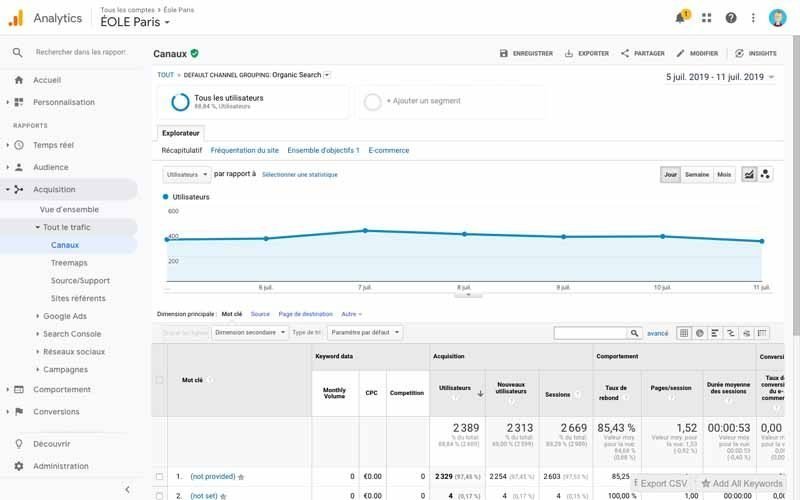
Google Analytics is a tool developed by Google that provides valuable information about a website. After adding the tracking code to your website, you will receive detailed data about your website traffic. This allows you to track your users, their geographical location, their interests, the devices they use to access your website, their dwell time and their bounce rate.
You can also get data on the amount of direct and organic traffic you receive. Finally, you can see how your website is performing in terms of speed and content.
You can use this google guide to learn more about this powerful free tool and my article oninstalling Google Analytics can help you.
Google bomb or Google bombing
Google bomb is a search engine optimization method that aims at manipulating the search engine results by displaying in the SERP a person or an organization unrelated to the keyword of the query.
This practice is generally used for humorous purposes and we distinguish for example the query “idiot” that refers to images of Donald Trump or “miserable failure” referring to George W. Bush in the results.
Google bowling
This is a Black Hat SEO technique that consists of creating backlinks to a competitor on irrelevant and spammy websites with the objective that the competitor is penalized. This is likely to reduce the rank of the latter in the SERPs and allow the one who does it to gain in ranking.
Google AdWords
See Search Engine Advertising
Google Keyword Planner
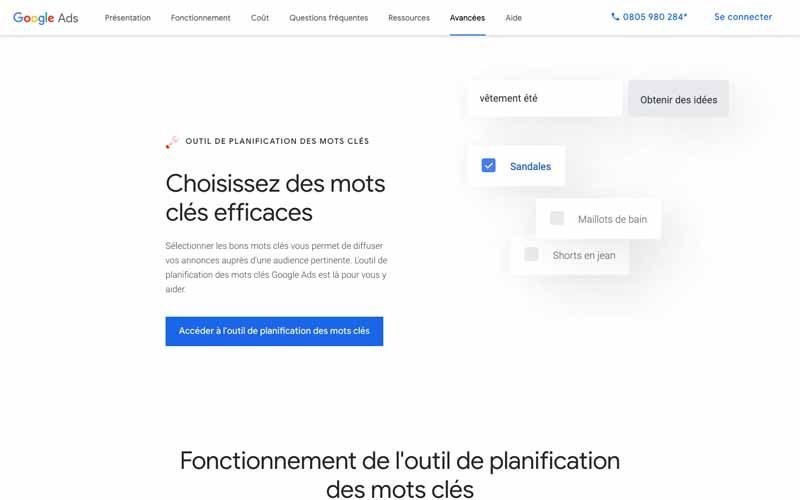
Google Keyword Planner is a tool that allows advertisers to determine the level of traffic they can potentially obtain with a certain budget and a certain campaign. The tool also offers the possibility to estimate the possible costs of a group of advertising campaigns.
It should be noted that the keyword manager can only be used with a valid AdWords account. In addition to being used for search engine advertising or SEA, the tool also helps copywriters and SEOs to effectively perform keyword research.
While this tool is very effective, Google points out in its guide to thekeyword planning tool that several factors can affect the performance of a campaign including:
- Your budget;
- Your bidding ;
- Your products;
- The behavior of customers in your sector.
Google Knowledge Graph
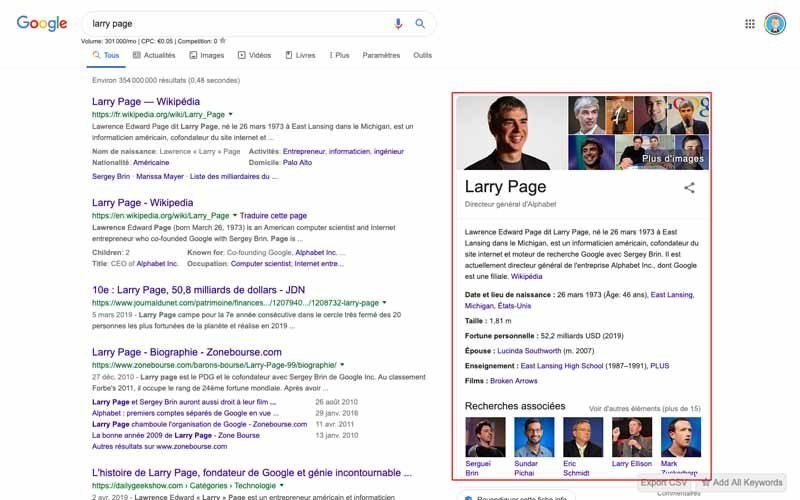
The Google Knowledge Graph is a knowledge base added to Google in 2012 which allows to have a compilation of information on a semantic entity. It is for example about :
- Of people ;
- Of places ;
- Of company ;
- Etc..
This related information is displayed in a dedicated area in the search results and comes from various sources. On computers and tablets, the Knowledge Graph is displayed on the right next to the organic search results. On smartphones, the display is above the search results.
The following items can be included in the Google Knowledge Graph among others:
- Data about a business, person or location;
- Images with a link to Google Image Search;
- Text snippets with links to the sources;
- Information about similar search queries “other also searched”.
This is a real time saver for users and you can also adopt certain practices to appear in the Google Knowledge Graph in order to gain visibility.
Google Lighthouse
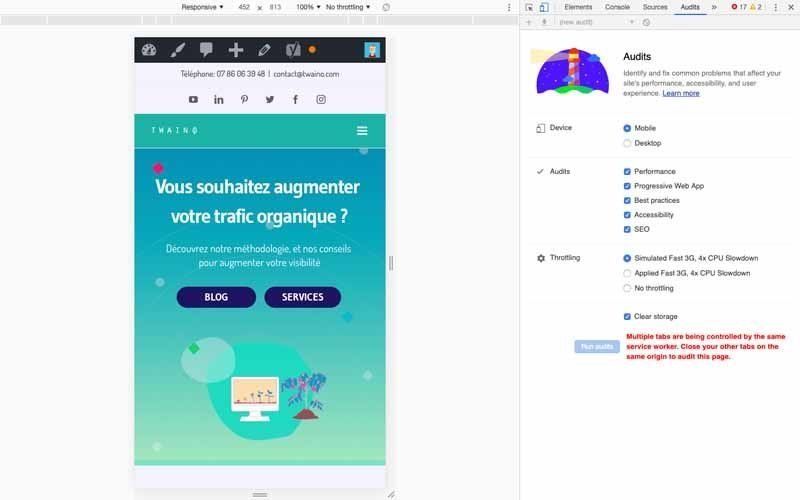
Google Lighthouse is an open source tool to perform technical audits of websites. The tool was developed by Google and analyzes the following aspects of a URL: Performance;
Progressive web application ;
Accessibility
Best practices ;
SEO
The Lighthouse framework has already been integrated into other Google performance analysis tools, such as PageSpeed Insights and browser-based audits via the chrome browser.
With the data that the Google Lighthouse provides, there is no doubt that it is a valuable tool for SEO and I encourage you to take a close look at the use of Google Lighthouse. This article from geekflare is likely to help you understand how to test your website with this tool as well.
Google Maps
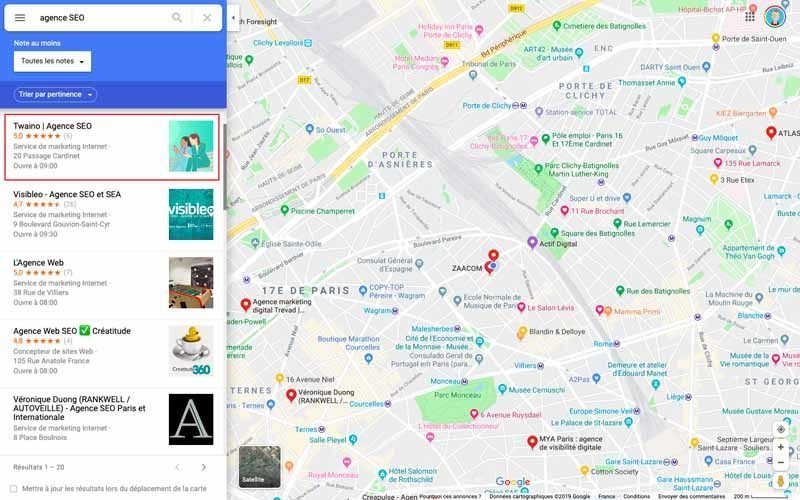
This is one of the most popular online mapping services, if not the biggest. It is very easily accessible and remains completely free. Google Maps offers users many services.
Indeed, Google Maps can be used for your own location and you can find routes from point A to point B. Here it is possible to choose whether you will go on foot, by bike, by public transport or by car. If you don’t know how to use it, this practical guide from Google can help you a lot.
In terms of SEO, it is a real lever since SEO Expert estimates that: ” 78% of geo-targeted mobile searches result in an offline purchase “. It is therefore a real source of traffic, especially since results from Google Maps often appear at the top of search results.
Google Mobile-Friendly Test
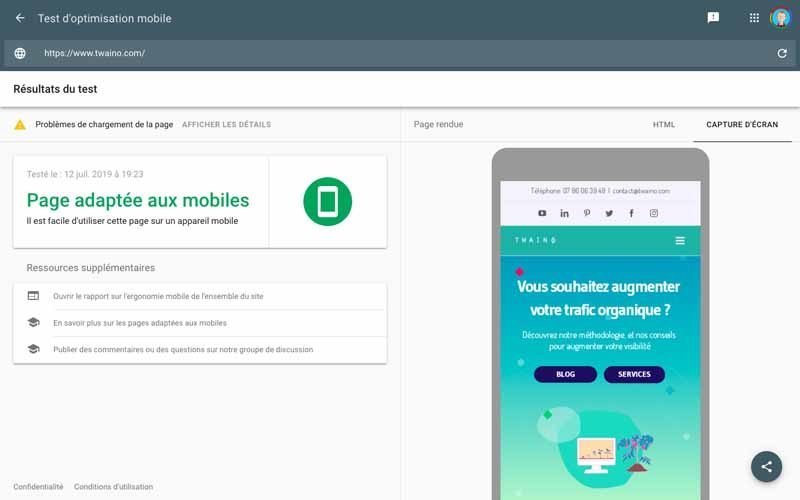
According to sEO statistics : ” 57% of consumers said they would not recommend a business with a poorly designed mobile website “. This statistic clearly indicates the importance of making websites responsive so that they can be adapted to mobiles.
Indeed, the user experience is a very important factor at Google and given that many users are now browsing from their cell phones, the firm has made the comfort of mobile use, an important ranking factor.
For this, Google has set up the Google Mobile-Friendly Test, a tool to test the performance of pages on mobile. To do this test, go to Mobile-friendlywhich allows you to have a score and a list of problems as well as the steps to solve them.
Google My Business
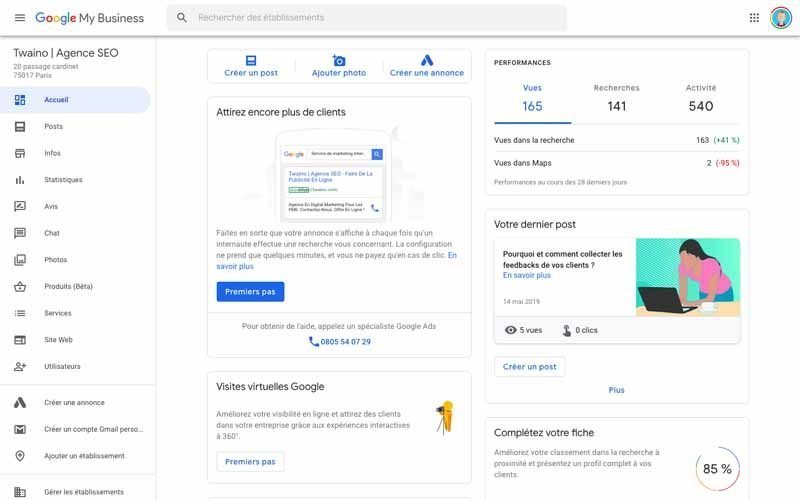
Google My Business is a tool that allows you to create and update a business listing. This is an important lever in SEO as the information you set here will be used in local search results and display your business in Google Maps.
It will also be used to display a Business panel to the right of the traditional search results in SERPs that includes, among other things
- Images;
- Location on the map;
- Business hours information;
- Phone number;
- Website;
- Etc..
Its use has many advantages and I invite you to consult my article on creating and setting up Google My Business.
Google PageSpeed Insights
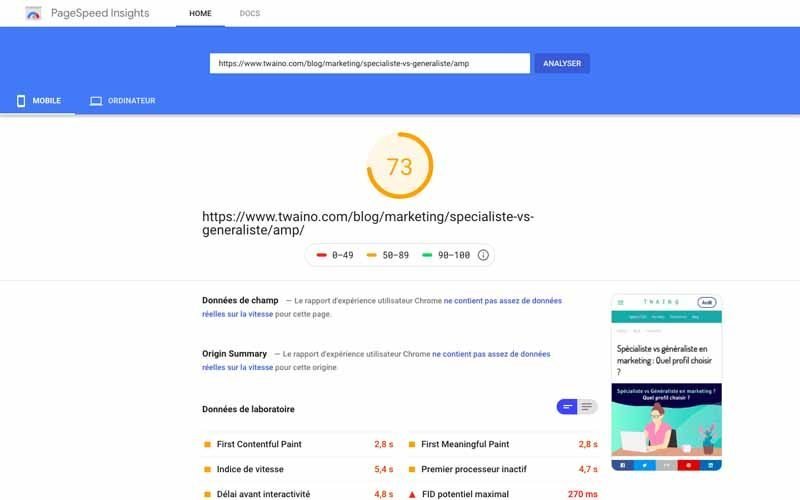
Google PageSpeed Insights is a tool that analyzes the content of a website to determine the speed of the page and the steps to take to speed it up. Google gives more explanation about its tool in its article about PageSpeed Insights.
Google Search Console
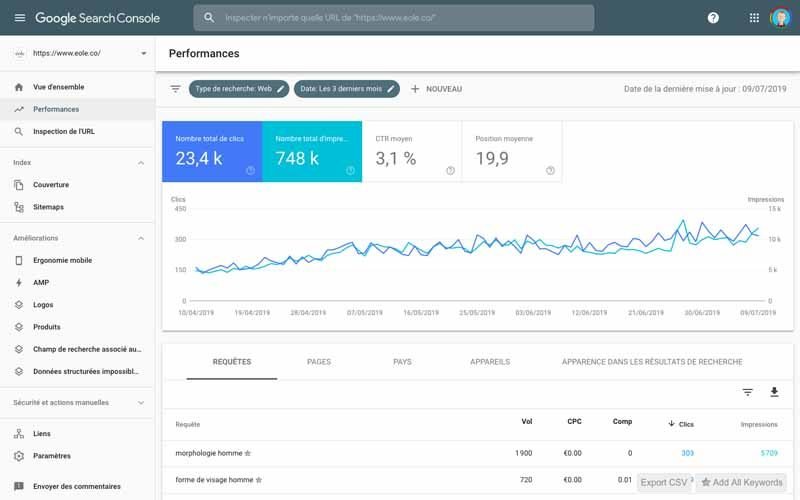
Initially called Webmaster Tools, the Search Console is an advanced tool to optimize the visibility of sites in its search results. For the american firmthis tool is: ” a free service that we offer to help you monitor and maintain the presence of your site in Google search results, and to solve any problem that may arise. You do not need to register with Search Console to appear in Google search results. However, by signing up, you will be able to better understand how your site is displaying on our end and optimize its ranking in search results. “
To go further on the subject, check out this article that also shows the steps to follow to register on the Search Console.
Google Trends
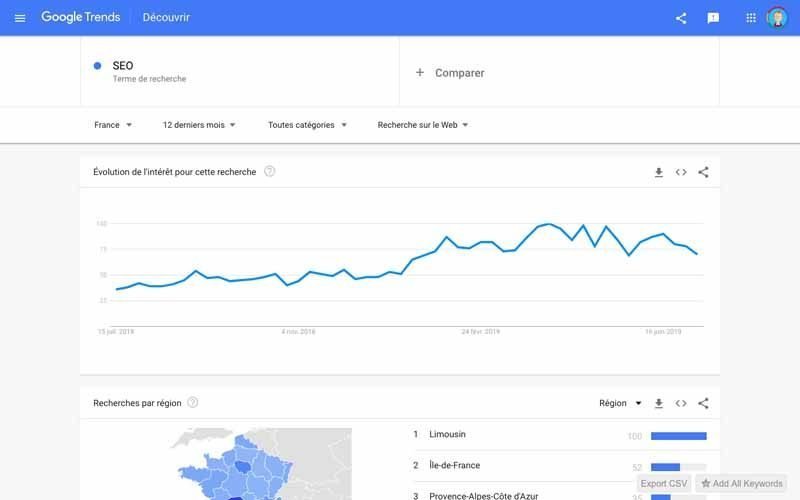
Google Trends is another Google tool that allows you to check the trend of keywords and expressions, via graphs that indicate the volume of searches over a period of time.
This is therefore valuable information that can help you in the development of a good strategy, especially since the trend of keywords or themes often seems to change during the year. In this way, you will be able to create your content by integrating your keywords according to their search volume during the year.
The support of Google provides some information on its tool, but if you want to go further, Ahrefs is a good source to consult.
Grey Hat
The Gray Hat includes SEO practices that are technically allowed, but are ethically questionable. One of these practices is the buying/selling of links that are almost untraceable when they are directly related to your theme.
It is true that this practice does not penalize you directly, but it is not considered ethical. The same goes for buying “likes” and “shares” on social media.
H
HTML sitemap or HTML sitemap
Unlike the XLM sitemap dedicated to search engines, the HTML sitemap is intended for visitors and is presented in the form of a bulleted list. Thus, it displays the links towards all the pages of the site by showing its hierarchy, which helps the visitors to navigate easily.
The HTML sitemap is often established during the development phase of the website to ensure a consistent structure that will provide an optimal user experience.
Although they do not have the same SEO weight as XML sitemaps, they are not completely without SEO value and it is relevant to create a good sitemap.
Hypertext Transfer Protocol (HTTP)
Also known as Hypertext Transfer Protocol hTTP is the communication protocol used to send and receive information on the web. In terms of SEO, it is preferable to use the secure type HTTPS.
Hypertext Transfer Protocol Secure (HTTPS)
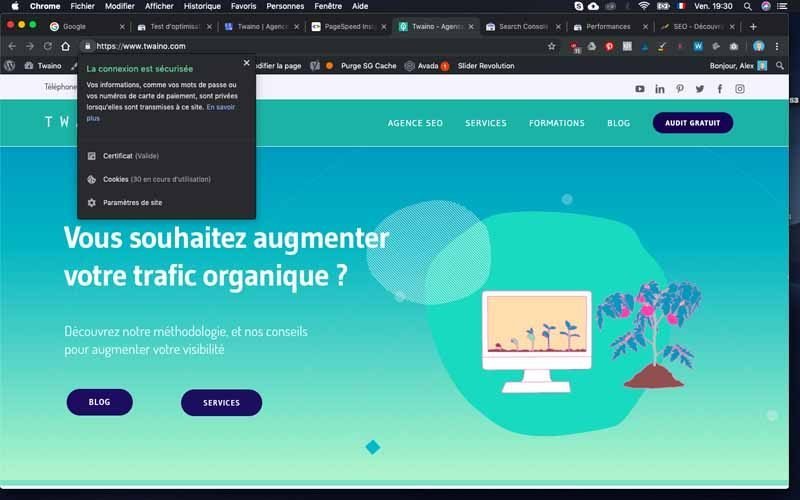
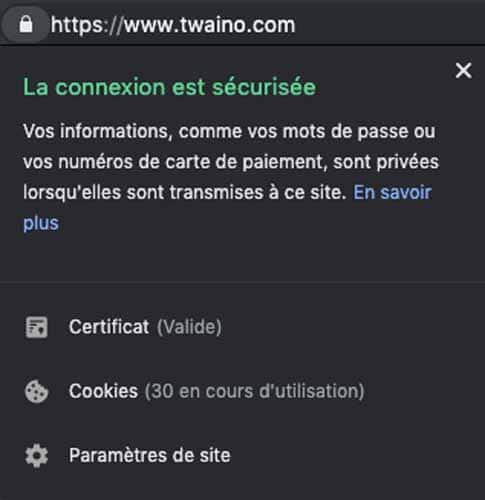
The Hypertext Transfer Protocol Secure is the secure variant of HTTP with the use of SSL or TLS protocol. Google defines it as: ” an Internet communication protocol that protects the integrity and confidentiality of data during the transfer of information between the user’s computer and the site “
The firm also added: ” We encourage you to adopt the HTTPS protocol to allow users to safely view your website, regardless of its content. “
Indeed, Google favors websites under HTTPS protocol in its ranking and if you are still in HTPP, switch to HTPPS to improve your ranking.
I
Image SEO
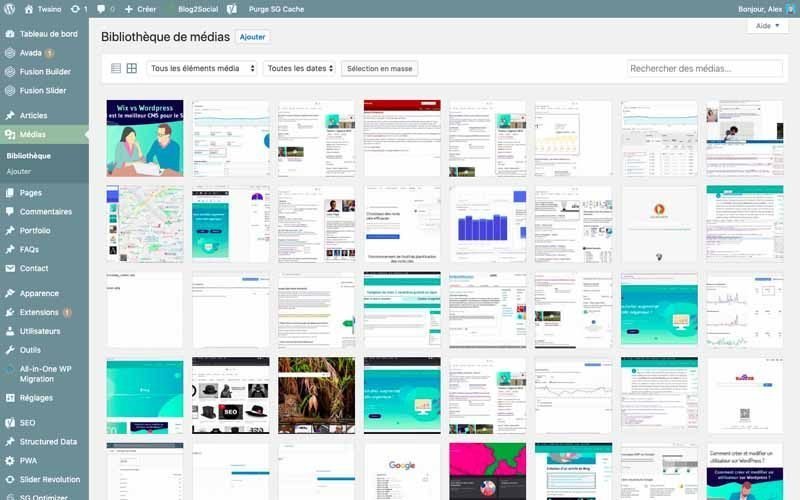
Image SEO or image referencing refers to the various practices of optimizing the images of a website in order to increase the relevance of the content, visibility on search engines and accessibility on the screen of readers.
The actions to be taken for this kind of SEO are among others
- The use of descriptive file names;
- The choice of quality files with the right size;
- The addition of alt tags with a description of what is on the image
- The creation of image sitemaps;
- Etc….
To go further on the subject, consult this resource from webrankinfo to optimize your images.
Image sitemap
This is an XML file that includes all the images of your website that you want to crawl and index by search engines. It can be a separate file or added to the existing XML sitemap.
Google believes that: ” Image sitemap information allows us to identify images that might not otherwise be considered (e.g., images accessed through JavaScript code), and to tell us which images on your site you want us to crawl and index “.
Creating this file can therefore help you improve the indexing of your website’s pages, which is always a plus point for your SEO.
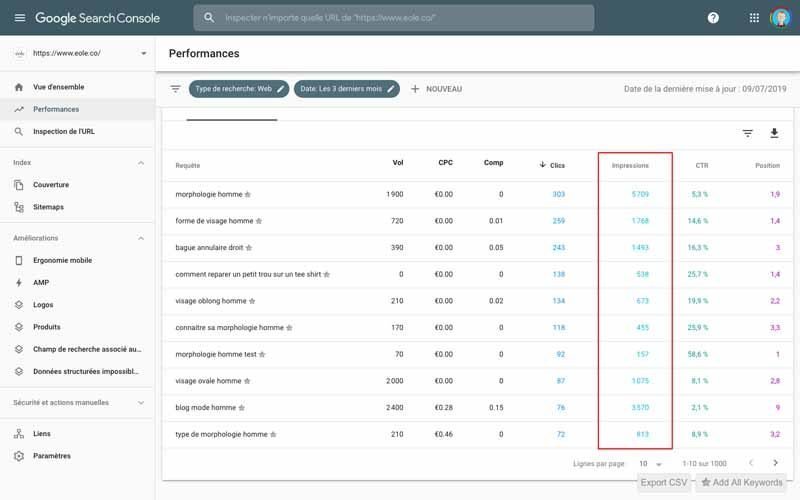
Every time an ad is displayed on the user’s screen or a website is displayed in the search engine results is considered an impression.
Index
The index is the database of a search engine and includes all the data that the crawler has been able to explore on websites. When a site or a web page is found in the results of search engines, it is included in the index. Otherwise, it is not in the index.
It is very easy to check if your web pages or site are included or in the index of search engines.
Indexing
Indexing is the process of including a site or web pages in the index of search engines. Indexing immediately follows the crawling of the search engine robots. However, Google believes that: ” Although most pages are crawled before indexing, Google may also index pages without access to their content (for example, if a page is blocked by a robots.txt directive) “.
Your website may not be indexed quickly and to speed up the process, I invite you to consult my article on indexing by Google.
Infographic

The infographics are liked and shared three times more than other types of contentinfographics are liked and shared three times more than other types of content, so they should be included in a content creation strategy. Indeed, they are graphic or visual representations of information that allow a quick and easy reading.
They are more engaging than a classic article since they convey complex data in a simple way. In addition, they sometimes take less time to create and get more natural links.
Interstitials
An interstitial is a promotional page included in the regular content of a website. They are for example intrusive pop-ups that cover the whole page of the website and that the user has to close manually to continue his navigation. This type of content negatively impacts the user experience and your website can be subject to penalties if interstitials are abused.
K
Keyword analysis or Keyword analysis
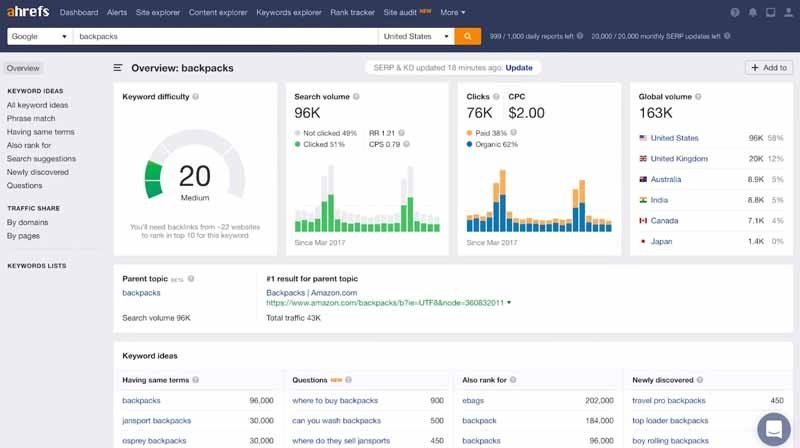
This is the process of evaluating all the keywords you are using as well as those you have discovered during keyword research. There are several parameters to consider and you can use tools such as :
- Ahrefs
- SemRush ;
- Keyword Spy ;
- Long Tail Pro ;
- SpyFu ;
- Quicksprout ;
- Alexa ;
- Etc..
By mastering these analysis tools analysis tools, you can easily choose the right keywords to improve your SEO.
Keyword cannibalization
According to seoquantum, : ” Keyword cannibalization occurs when several pages of the same site are optimized on the same keyword
In fact, this phenomenon generally affects blogs with large volumes of content, especially since some keywords will tend to be repeated. Note that keyword cannibalization can have negative consequences on SEO and make you drop in terms of ranking in the results.
It is therefore necessary to to identify if your website is subject to keyword cannibalization and to adopt practices to fight it or to avoid it.
Keyword competition or keyword competition
This is a measure that determines how difficult or easy it is to position yourself on a keyword given the competition. Indeed, the traffic for popular keywords or which are the subject of a large number of requests is generally high. This encourages many SEOs to position themselves on these keywords, increasing the competition. For this reason, it is very important to analyze and choose strategic keywords.
Keyword funnel
Set up a a sales or conversion funnel is a strategy that can significantly increase sales. This marketing technique is based on the consumer buying process which consists of several steps that you can optimize with certain keywords, i.e. keyword funnels. You can also classify them according to these steps in order to increase your conversion rate.
Keyword proximity or proximity of keywords
The proximity of keywords is the distance of keywords on a web page. For example, for the expressions “keyword proximity” and “proximity of your keywords”, the distance between the words “proximity” and “keywords” are not the same. The concept of Keyword proximity indicates that the shorter the distance, the more relevant the web page becomes.
Keyword rank
This is your position in the SERP lists for a specific keyword and several tools can determine its keyword rank including :
- SEMrush ;
- AccuRanker ;
- Ahrefs ;
- SERPWatcher ;
- Google Rank Checker ;
- SERP’s Keyword Rank checker ;
- SEOCentro Rank Checker ;
- Etc..
Keyword stuffing or accumulation of keywords
Keyword stuffing is a black hat SEO practice that consists in repeating a keyword many times on the same page, in order to make the algorithms believe that the content is relevant for this keyword.
On this subject, Google indicates: ” Inserting keywords or numbers into pages negatively affects the user’s browsing experience and can hurt your site’s ranking. Strive to create useful and relevant content that uses keywords appropriately and in context. “.
L
Landing page or Landing page
The landing page is a specific page that appears when a user clicks on a link. They are usually linked to marketing campaigns and are often optimized for conversion or promotion.
Landing pages play a crucial role especially when you set up a conversion funnel in order to efficiently generate sales. To do this, it is important to use best practices to set up your landing pages.
Latent semantic indexing keyword
Also known as LSI keyword, these are actually words or phrases semantically related to a main keyword. This is because LSI keywords share the same context and are frequently used or found together. They are for example ” link “, ” linkbuilding “, ” backlink “, etc..
Lsikeywords is a tool that can help you discover LSI keywords related to your main keyword. That said, you should be careful to choose the right keywords in order to really strengthen your SEO strategy.
Lead magnet
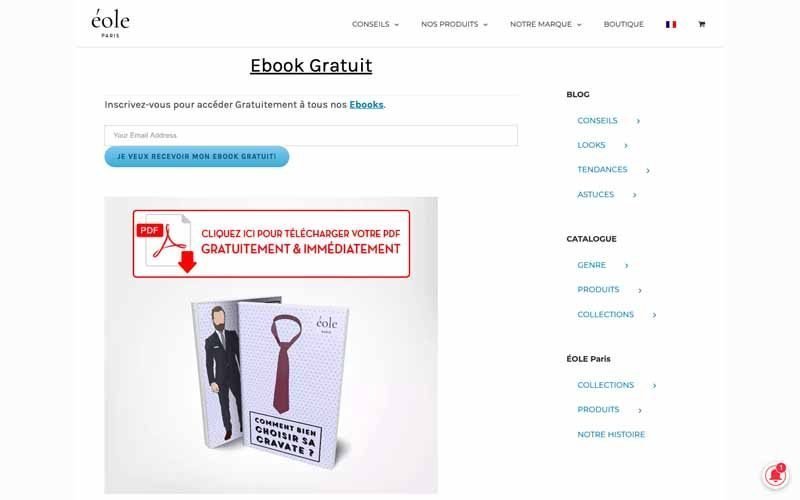
A lead magnet is a content whose role is to encourage visitors or potential customers to leave their email or other contact information. This is the case for example with free ebooks that are offered in exchange for the email of visitors to a website.
This tool builds an email list that can be used for other marketing strategies. Setting up a lead magnet is a very good strategy to effectively generate leads, but it depends on your ability to generate traffic. Moreover, this tactic only brings real results if you manage to create the perfect lead magnet for your audience.
Internal link
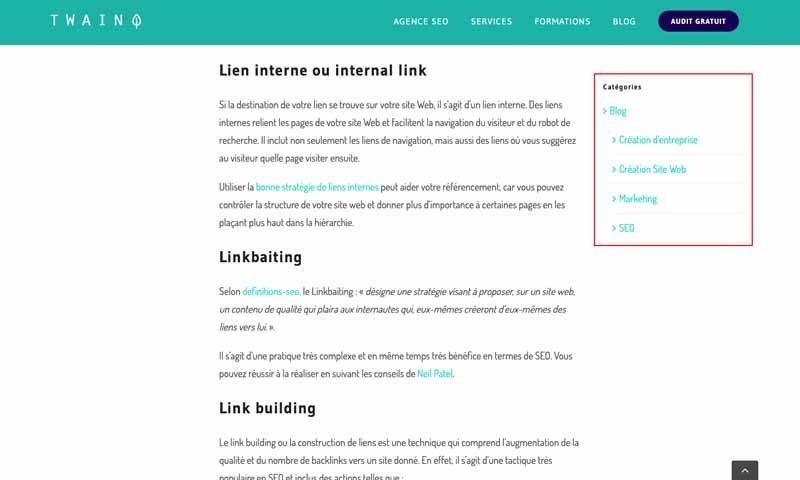
If the destination of your link is on your website, it is an internal link. Internal links connect the pages of your website and make it easier for the visitor and the search engine to navigate. It includes not only navigation links, but also links where you suggest to the visitor which page to visit next.
Using the right right internal linking strategy can help your SEO, because you can control the structure of your website and give more importance to certain pages by placing them higher in the hierarchy.
Linkbaiting
According to definitions-seo, linkbaiting: ” means a strategy to offer, on a website, quality content that will appeal to Internet users who, themselves will create links to it. “.
It is a very complex practice and at the same time very beneficial in terms of SEO. You can achieve it by following the advice of Neil Patel.
Link building
Link building is a technique that involves increasing the quality and number of backlinks to a given site. Indeed, it is a very popular tactic in SEO and includes actions such as :
- Joining bloggers and influencers;
- Submitting your website to a directory:
- Writing guest articles;
- Leaving links in comments of blogs and forums;
- Etc..
To go further, I advise you to read this article by Neil Patel on good link building practices to adopt.
Link burst
The link burst occurs when you gather in a very short time a large number of backlinks. However, this phenomenon alerts very quickly the search engines that seek to determine if the site in question is reputable and if the sites from which the backlinks come are of quality.
That said, the link burst is acceptable when it is a viral content that has created many backlinks.
Link farm
Known in French under the expression link farmlink farm is a technique that aims to manipulate search engines using a group of websites that are all linked. These are usually managed by automated programs and services.
It should be noted that heavy penalties can occur and Google makes it known that: ” Any link intended to manipulate a site’s PageRank or ranking in Google search results may be considered part of a linking scheme and a violation of Google’s webmaster guidelines. “
Local citation or local citation
This is any mention of:
- The company name;
- Website address;
- Physical address;
- The phone number of a local business;
- Etc..
This information can impact the ranking in local search engines and at the same time make it easier for users to find and learn about businesses. It is therefore a concept to discover to optimize your local referencing.
Local SEO or Local Referencing
Local SEO includes all the practices used for the optimization of traffic based on geolocation. Indeed, 46% of searches on Google have a local setting and it would be a shame in terms of SEO not to position yourself on this lever.
To go further on local SEO, here is a complete guide by Neil Patel.
Local search or local search
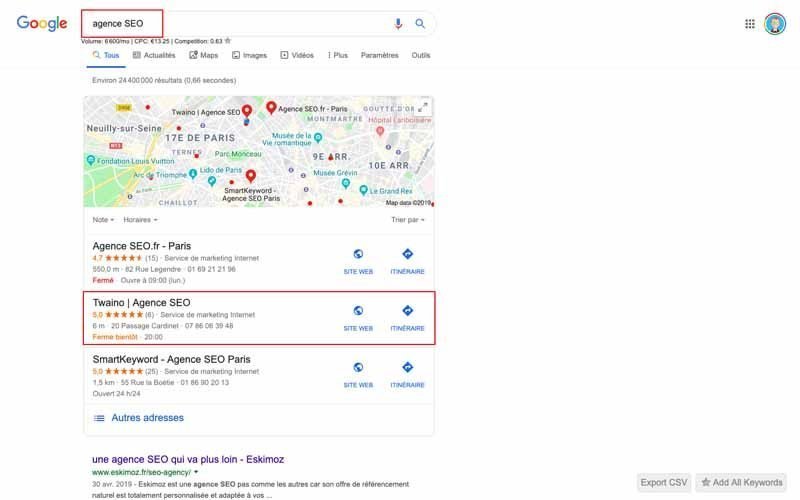
According to definitions-marketing : ” Local search means, in the field of SEO, a query made on a search engine that includes an element of geographical location such as “hairdresser Paris” or which by its nature is considered local by Google. “
Long tail keyword
A very specific phrase usually consisting of three or more words.
They are generally used by people who want to obtain a specific piece of information, or who are about to make a purchase. The conversion rate is therefore generally much higher than ordinary keywords. To go further on this subject, this article from morningscore is likely to help you.
M
Mirror site or Site miroir
A mirror site is a complete replica of a website that has a different URL. They are used when the original website generates too much traffic for the server to handle.
Mirror sites serve people in different locations (different continents) and ensure a good user experience and fast page loading.
Mobile-friendly website

This is a website optimized to display properly on a mobile device. This can be done in two ways, either by having a mobile version of your website or by making it responsive. From an SEO point of view, we obviously recommend the second option.
Mobile first indexing
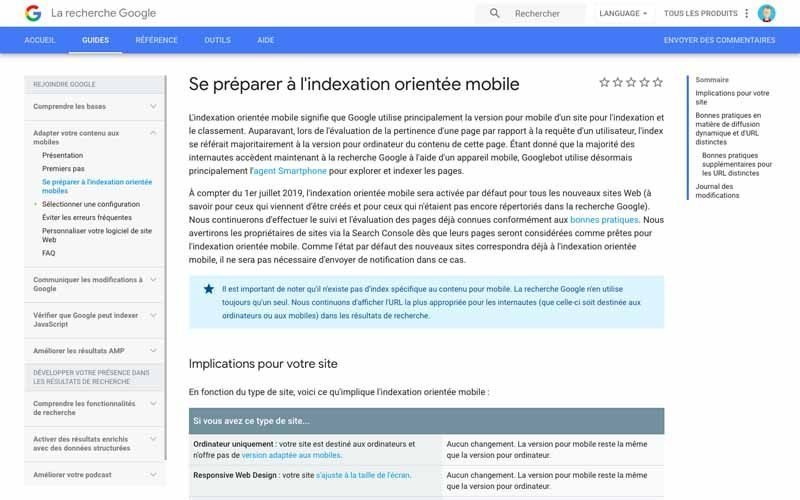
This is an approach to indexing where the mobile version of a website is crawled and indexed first. The desktop version of the website will still be indexed and ranked, but if it is not optimized for the phone, it will have a negative impact on SEO.
Keyword
These are the words or phrases that users enter into the search box in order to get a specific content. Specifying a keyword and using it in your content helps search engine spiders categorize your website and display it for the right query.
To find out which keywords can increase your traffic, install Google Search Console which is a very powerful tool.
Search Engine
A search engine is a program that searches all files on the World Wide Web, categorizes them by keyword and stores them in a database.
When a user enters a keyword, the search engine displays files that are considered relevant for that keyword.
Google, Bing, Baidu, DuckDuckGo, Yandex, Yahoo, Ask.com, Wolframalpha and AOL.com are currently the most used search engines.
N
Negative SEO
This practice is used by people who want to destroy the e-reputation of their competitors. It consists of violating the guidelines of all search engines in general and Google in particular. From multiple techniques are used for this practice. However, it is possible not only to know when you are victim of Negative SEObut also to protect yourself against this use.
NoIndex
This is an attribute that is added to a meta robots tag. Thanks to it, search engines are informed that the page should not be indexed in their database. Several reasons can be at the base of such a decision especially when the website is under construction.
However, Google has announced that this method will no longer be taken into account from the end of August 2019. You will have to find an alternative if you are among those who use it.
Nofollow
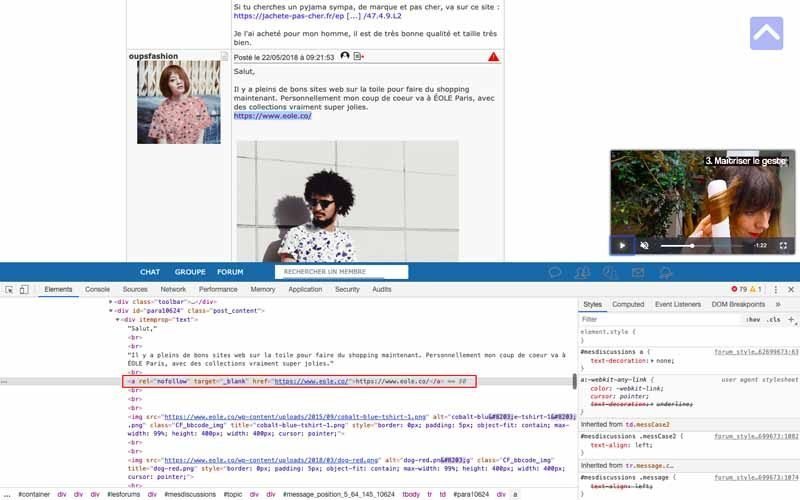
This is one of the values of the rel attribute. Its role is to indicate “that a link should not be followed”. We can decide to use Nofollow for several reasons. But be careful, it is a value that would also no longer be taken into account by Google from September 2019.
Noogler
This term refers to a newly employed person at Google. Such a person can be recognized by the cap made in the company’s colors and overhung by a propeller that he or she wears at the beginning. Among the cap wearers who made the buzz, we can recognize the famous Danny Sullivan.
(Not provided)
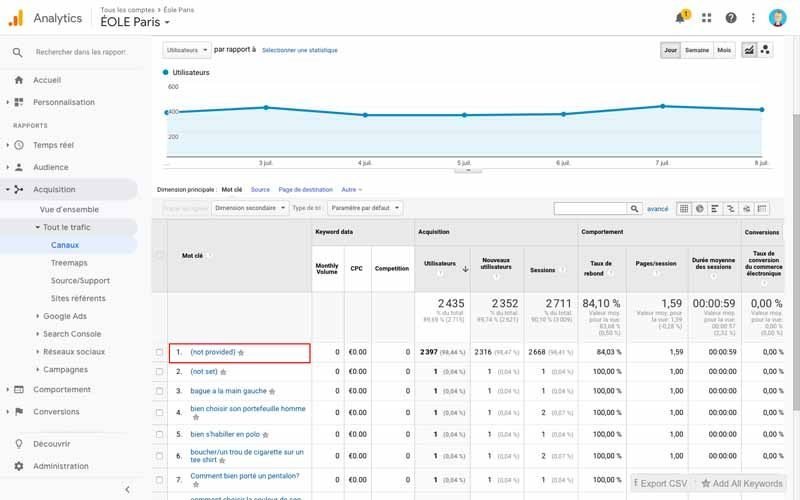
Google uses these words to “protect the privacy” of its users. Indeed, when you browse the search engine, whether in private or connected mode, your queries are no longer sent to the audience measurement tools. Instead, it will be displayed with the words instead, Google Analytics will display the words ” not provided ” or “No data is available for this display”.
However, let’s not forget that Google is a big advertiser. Therefore, its concept of “privacy” is a bit lowered when it comes to sponsored links or SEA. In these cases, the queries are indeed displayed.
O
Link obfuscation
This is a process that hides a link from Google robots, but leaves it available to Internet users. It is a practice that allows to optimize the internal mesh of a website as well as the “distribution of juice between pages”.
It is used most of the time as an alternative when we can not use the noindex or nofollow, especially in the case of links “About us” or “Legal”. These pages have no use for natural referencing, but can be useful to Internet users and sometimes even mandatory from a legal point of view. It is thanks to Javascript that the obfuscation of links can be implemented.
Onebox
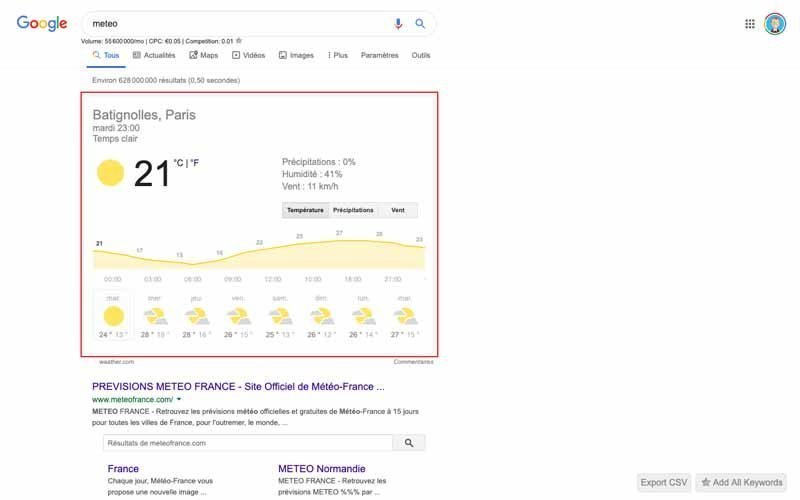
Otherwise known as “Direct Answer” or “Answer Box”, is a display box within the search results. It can be accompanied by either an image or a symbol.
It can be found at the position zero in the Google SERPs (a bit like the featured snippets). The Knowledge Graph often confused with the Onebox is a specific form of the latter.
Note that the Onebox is not a practice that is automatic: only a few requests trigger its display. Therefore, you can’t really set up an SEO strategy to be sure to appear. Here is how a Onebox can look like.
P
Local Pack
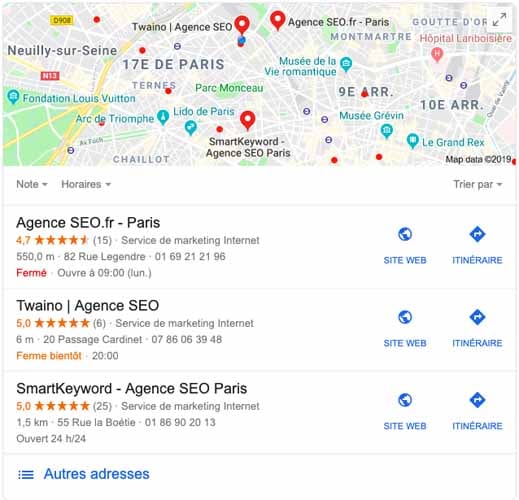
When a query is local, Google displays local results in a given location which is called a “local pack”. A local pack is made up of several pieces of information such as a Google Maps as well as the numbers… of the establishments associated with the query.
The local pack is displayed in batches of 3 since 2015. To be placed in this pack, you must have optimized your local SEO. This can be done if you are registered on Google My Business.
PageRank
Developed by one of the co-founders of Google, Larry Page and trademarked by him, the PageRank is an algorithm that evaluates the popularity of a web page in order to index it properly before its presentation to Internet users.
The PageRank has much less importance today than in its early days, but it is still a key element for SEO. PageRank is often associated with link juice or the ToolBar PageRankwhich has disappeared.
Pagination
By definition, pagination is a technique to organize the pages on a website. It is a numbering that is often found either at the top or bottom of the site. For this practice, we use pagination tags.
Panda
This algorithm of Google was created in 2011. Its role is to check if the content of your website is poor qualitatively or quantitatively and if it deserves to be seen by Internet users.
PBN or Private Blog Network
The Private Blog Network is a network of interconnected sites that are all linked to a main website called the money site.
The PBN aims to “push” the latter so that it is better indexed and referenced by search engines. Note that the PBN is a practice that is prohibited by Google. If you still want to violate the guidelines, you must be very careful.
Monthly penalties
Referred to as “Monthly Actions” by Google, monthly penalties are a kind of ticket that the search engine sends to users who violate the “guidelines”. These penalties are sent by Google’s evaluators, either by the Google Search Quality or by the Webspam Team.
You are therefore likely to receive a message in your mailbox if users have reported your site as containing too much spam, too many artificial links or other
It is in the Search Console that you will find the monthly penalties in the “Search Traffic” tab. Fortunately, there are steps you can take that you can take when a monthly penalty has been issued to you.
Penguin
The role of this algorithmic filter is to penalize websites that use over-optimized SEO methods. Since the year 2016, Penguin has a real time operation. In other words, if you receive a penalty, it is immediately taken into account by the algorithm. Thus, you do not risk being too affected by the penalty if you correct it quickly.
Moreover, it is interesting to know that the French definition of Penguin is not penguin. Penguin is a seabird that can fly, while the French definition of penguin is that it cannot fly.
Pogo Sticking
This term refers to the action of the Internet user who will click successively on each link found on a web page and will always return to the starting page thanks to the “back” button of his browser.
As long as a relevant answer to his query is not found, the Internet user keeps going back and forth between the results pages and Google.
In reality, this name comes from a toy, the pogo stick or jumping stick. This toy allows you to make bounces exactly like a kangaroo would.
Zero position
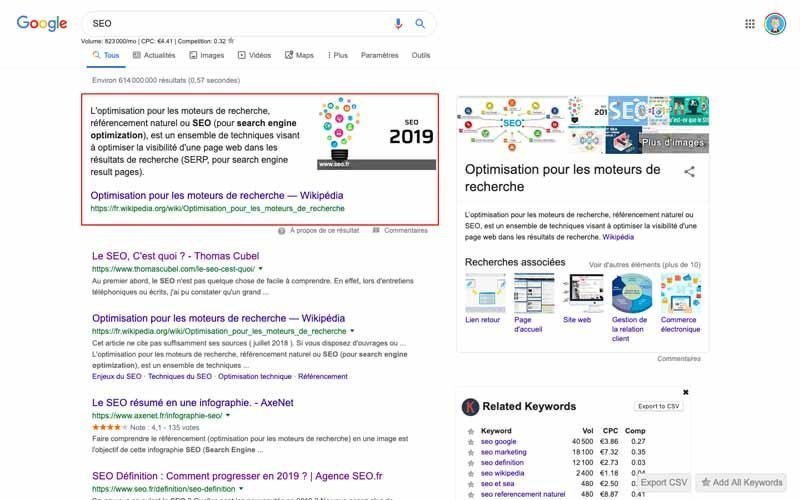
We find at the level of this famous position zero, all the information that are above the natural links of the Google results page. This is a position that interests many SEO specialists, because it leads to the generation of a high number of traffic, which is a definite advantage for SEO.
We can find in this position elements such as the featured snippet or in the onebox results that Google provides. Here some examples of elements that can be found in the zero position.
Q
Quality Raters
Google Search Quality Raters or simply Quality Rater are people whose role is to judge the quality of the results that Google returns. Although these people work for the Californian search engine, they are not directly employed by Google.
In fact, they are people who, most of the time, work from home as subcontractors. The names of some of the third-party agencies with which the group partners are well known. These include Lionbridge, Leapforce and Butler Hill.
Quality raters are not professionals of SEO PROFESSIONALS, their task is to send back some results to Google’s engineers so that they can make improvements on the algorithms if necessary.
The Quality Rater gives ratings. They can not remove or give a penalty to a website. They receive, to help them in their task, a guide that you can also consult.
R
Rank Brain
This is an algorithm whose author Greg Corrado, is a specialist in artificial intelligence and machine learning. We find these two specialties in the algorithm.
The objective of the integration of artificial intelligence is to “translate” the user’s request to Google. The interpretation of the query is improved. This algorithm aims to enrich Google’s database by learning new words and expressions.
It also allows a more efficient understanding of voice queries that seem complex. RankBrain is also a logical follow-up to thehummingbird algorithm launched by Google in 2013
Since 2015, the Google RankBrain algorithm is used and it is estimated that 15% of Google queries are processed by this algorithm.
Universal search
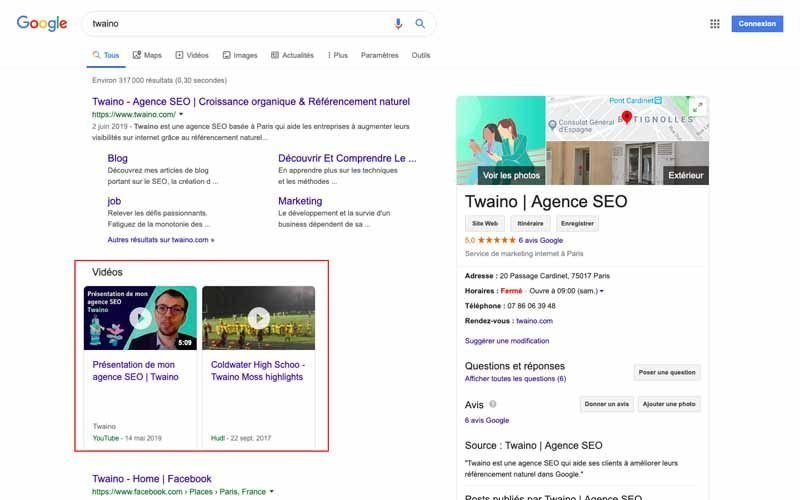
Universal search refers to the traditional results obtained on Google SERPs but combined with other complementary media such as images, videos, maps, local businesses and many others. It is a solution from Google to boost results by mixing Google Images and Google News results on a single SERP.
301 redirect
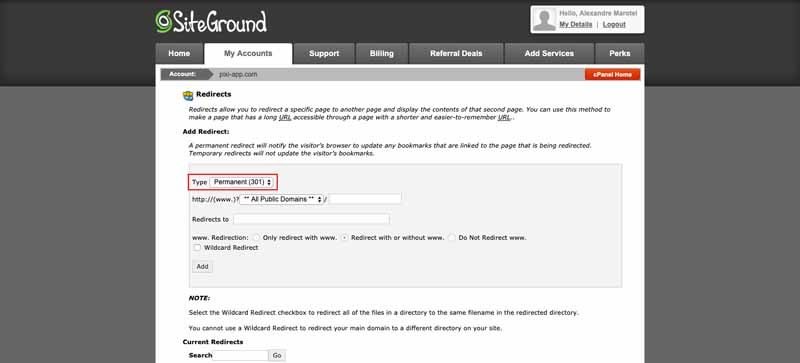
Its role is to indicate to search engines that the address of a web page has been changed permanently. This means that you should also think about changing the URL of the page. This practice can also be called “web redirection” or “permanent redirection”.
The principle of 301 redirection was established to allow SEOs to have a better relationship with Internet users. Indeed, a referrer may judge that another content would be more appropriate to the address where the user would like to go.
A 301 redirect is more efficient when it is done in the Htaccess file file of the server.
302 redirect
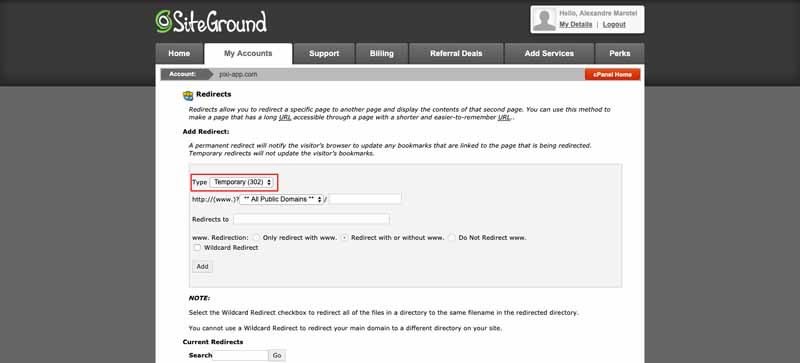
It also indicates a change in the web address, but temporarily. If you have a problem with 404 errorspages, this redirection can be useful. It can also be useful when you have pages on your site that are not yet active, but will be in the near future.
Nevertheless, for a good SEO, it would be better to use a 301 redirect rather than a 302 redirect. Note that the 302 redirect must also be done at the server level in the Htaccess file.
URL rewriting
There are URLs that are sometimes a little too complex and that confuse search engines and can even scare away Internet users. These can indeed contain special characters such as “?” or ” &” often essential in a dynamic page.
It is to overcome this problem that the principle of URL rewriting was created. It is a technique that will allow to modify a web page to make it more readable to the Internet user. It is also very useful for SEO, because it tells search engines which keywords are relevant to the page. This technique has some other advantages from an SEO point of view.
S
Schema.org
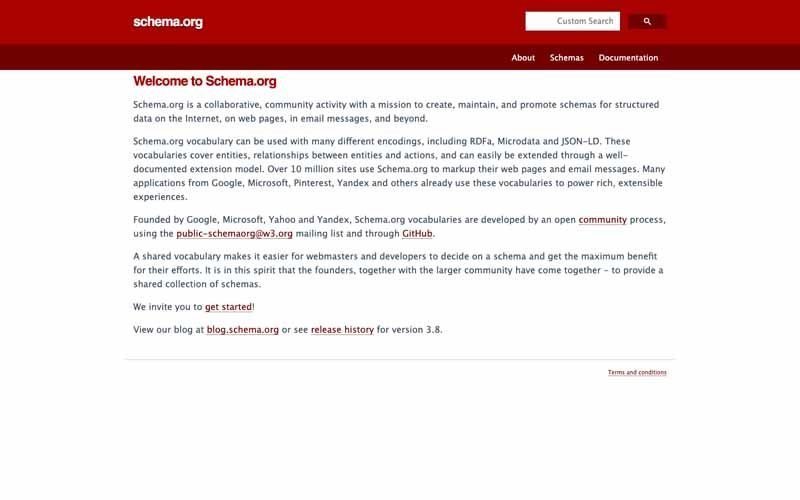
This is a computer project created since 2011 by the giants of the Net to optimize searches on the web. The idea is to bring together on Schema.org, the various structured data tags of the search engines Google, Bing and Yahoo and Yandex.
It should be remembered that structured data tags have proliferated at the time, which led to the need to establish a convention. A sort of standard portal that harmoniously combines the structured data tags of Google, Bing and Yahoo.
Today, the platform is a tool that provides all the information needed to insert structured data tags in any type of web page
Scooter
Scooter was the name given to AltaVistathe famous search engine of the 90s. Some time later, Scooter was dethroned by Yahoo and shelved.
Even if today, web referencing is at the cutting edge of technology and new digital solutions, its beginnings go back to AltaVista and its indexing robot Scooter. The latter was created by Louis Mounier and stood out from other robots with unmatched performance over time.
Indeed, it could index about ten million web pages and visit 2,000 sites every day. Even if nowadays, Googlebot can crawl 20 billion, Scooter remains the ancestor of all indexing robots.
Scrap
Scraping is copying information from other websites, either to duplicate another one or to use it locally. It is a kind of copy used in many fields and more frequently in Black Hat SEO processes.
Its purpose is to draw on information already developed and shared on the Net to build your project quickly and efficiently. Even if it is seen from a pejorative point of view, scrapping is not necessarily synonymous with stealing or plundering other people’s productions.
The proof is that Google scrapes a huge number of websites to achieve its indexation and guarantee better search results on the Internet.
In SEO for example, scrapping can focus on SERPs to know the positioning of a website. Today, the most used scrapping tools are : ScrapeBox ;
- Rddz Scraper;
- Screaming Frog Web Scraping
Search Engine Advertising or SEA
According to journaldunet : ” Unlike SEO (Search Engine Optimization), also called natural referencing, this is a paid referencing technique. In other words, we do not bother with SEO techniques that must seduce Google without paying him, but we agree to pay for the good visibility of his website in search engines. SEA, for Search Engine Advertising, is a form of referencing that allows websites to improve their visibility in the results pages proposed by search engines such as Google or Bing, but also via marketplaces such as Amazon
Indeed, this service was first offered to webmasters by Overture since the 90s. In France, Miva, formerly Expotting Media, was the first to experiment with the SEA concept.
Today, Search Engine Advertising is greatly improved and popularized by Google thanks to its product Adwords. Next to it, Bing also offers the Bing Ads system, always based on the SEA concept. To go further on the subject, this practical guide by Neil Patel will be of great help.
Search engine marketing or SEM
According to seo.fr : ” SEM (for Search Engine Marketing) is a global term taking into account all the techniques aimed at improving the visibility of an entity (site, company, person..) on search engines. Therefore, SEM is a grouping of marketing techniques and not a marketing technique in itself. “
In fact, SEM includes SEO, SEA and SMO.
Search Engine Optimization
Definitions-marketing believes that SEO: ” is the acronym for Search Engine Optimization and can be defined as the art of positioning a site, a web page or an application in the first natural results of search engines. In French, SEO is referred to as référencement naturel. “
Indeed, it is not about scrupulously meeting the needs of search engine robots, but rather ensuring a good experience for the user. Especially since this is what the search engine spiders are trying to verify by analyzing your website.
For have visibility on the internetsEO is a key lever that I invite you to consider with the utmost attention.
International SEO
- International SEO is a group of SEO practices that aim to increase your visibility in other countries and create global growth. It includes several tactics such as:
- Optimizing for the most popular search engine in each country;
- Using the hreflang attribute;
- Translating content;
- Using country detection to change the price currency;
- Etc..
If you need to expand your business internationally, I invite you to go further on the International SEO and then define the appropriate strategy.
Off-page SEO
Definitions-marketing defines off-page SEO as: ” the part of SEO that does not happen directly on the pages to be promoted but aims to gain quality external links (backlinks) to promote the natural referencing of a website. Off-page SEO is actually essentially external netlinking. “.
In addition to netlinking, off-page SEO can include social media marketing, email marketing, influencer marketing, and even offline marketing channels. It usually complements on-page SEO and you can check out this article by Neil Patel to go further on the subject.
On-page SEO
Unlike off-page SEO, on-page SEO includes SEO practices that take place on a website. It includes, among other things:
- Publishing relevant, high-quality content;
- The optimization of the HTML code with the different tags;
- The architecture of the information;
- Website navigation;
- The URL structure;
- Etc..
SEO site audit or SEO audit of site

The SEO audit is a complete analysis of the visibility of a website on search engines. It aims to determine the problems in terms of SEO and solve them by developing a relevant strategy.
There are two types of audits you could do to get an overview of SEO issues:
- Technical SEO Audit;
- Content audit.
You can do them using some tools, but my Twaino Agency offers you a completely free SEO audit of your website.
SERP or Search Engine Result Page
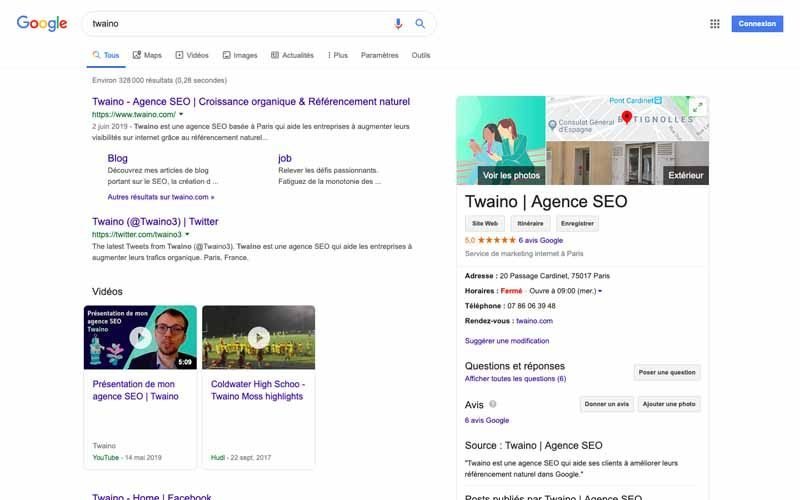
Wikipedia defines the SERP as: ” a web page that a search engine automatically generates based on keywords entered by a user, and which consists of a set of links pointing to resources that it considers, among all those it indexes, as relevant to this request in terms of its intrinsic ranking system. “
A SERP generally includes several elements including:
- Adwords advertising content;
- The Knowledge Graph;
- Universal search: images, news, shopping..
- The results in zero position ;
- Associated Searches ;
- The local pack ;
- Etc..
Silo
A silo is a tank designed to store various products. In SEO, the idea remains almost the same, except that the elements that make up a silo here, share the same theme in common. It is actually a portion of a tree structure that lists different options of the same theme.
Although siloing is not mandatory to have a successful website, it remains a very relevant method that you can implement.
Siri

Siri is the name that Apple dedicated to its voice assistant since 2011. Siri works on all Apple terminals, iPhone, iPad and MAC mobiles and has the ability to answer on the spot all the questions asked in natural language.
Voice assistants have become so popular lately that each brand has decided to make it their own. From Amazon Echo’s Alexa to Google Assistant through Microsoft’s Cortana and Apple’s Siri, manufacturers have only one vision: to impress the consumer for more loyalty.
At Apple, Siri is able to perform the basic functions of a phone: calls, text messages, web and route searches, settings and can also entertain the gallery by instantly answering questions of general knowledge or humor.
One Page Site
As its name already indicates, a One Page website is a website that fits on a single page. Generally, this single page is very long and requires the use of the scroll bar.
To facilitate navigation on these types of sites, the main ideas developed on the page are divided into internal links that lead to the exact part concerned
On the other hand, there are websites that are too large in pages and that require silos to organize these pages by theme.
The creation of such sites may seem relatively less difficult, but in SEO one Page websites cause some problems. In fact, since several topics have been addressed on a single URL, the SEO may have difficulty using the single URL for several search topics at once.
Slurp
Now called Spider, Slurp is the name given to Yahoo’s indexing robot. But since the search engine now uses Bing’s technology, its own crawler is hardly used.
In terms of crawlers today, Googleblot and Bingbot who are cutting the big part of the cake
SMO or Social Media Optimization
Seo.fr indicates that SMO: ” includes all activities aimed at developing the visibility of a company through social media. “. It is therefore the use of social media as a channel to increase :
- Your traffic ;
- The visibility of your company;
- The notoriety of your brand.
This practice does not directly impact search engine rankings, but be aware that 71% of customers would likely recommend a brand to other customers if they had a good experience with that brand’s social media services.
In view of this statistic, it would be relevant todevelop an effective SMO strategy.
Snippet

The snippet is a description preview of a web page on the SERPs. It can be represented as a dedicated written summary or simply the presentation block of the site.
Each response element in the Google SERPs is followed by a snippet that gives an overview of the site concerned. If a snippet provides a rich description, with the title, the URL, the summary… we talk about “rich snippet”.
It can also happen that the snippet just presents the textual summary of the site which is nothing more than the description contained in the tag “meta description” provided by the site itself.
Soft 404
Soft 404 is a page that, although the http header returns a 200 code, appears as a 404, and therefore displays an error page or a completely different URL. How does this happen?
Before Google or any other search engine returns a web page, it will consult the server hosting the requested URL, then load its content before displaying it on your browser. The information received from the server is followed by a coded http header interpreted as follows
- 200: OK. All is well, the browser will be able to load the requested page without difficulty;
- 301: The requested URL is no longer available but redirected to another URL;
- 302: The requested URL is temporarily unavailable, another URL is available in the meantime;
- 404: no web content is associated with this URL.
However, it happens that Google takes a URL whose http header is coded 200 or 301 as a 404 page. The page is therefore not indexed and displays “Page not found”.
Spamco
Spamco or comment spam is an old SEO process Back Hat which consists in injecting unwanted comments in active blogs or forums. The idea is to include a link to another site in the comment in the hope of optimizing its visibility on the web.
It must be said that this practice has had its day, but today it is totally ineffective.
The decline of Spamco started when websites warned their algorithm against such practices by putting Nofollow on all external links inserted by a third party.
Spam Report
A spam report is a possibility that Google offers to Internet users to denounce the authors of sites that circumvent the referencing regulations.
These malicious practices, called Spamdexingthese malicious practices, called Spamdexing, are numerous on the Internet and, moreover, go unpunished. Google has tools such as algorithm filters to track down these authors, but visitors can also participate by filling in a dedicated form.
T
Technical SEO or SEO technique
The referencing SEO is responsible for interacting with search engine robots for a good visibility of your site on the Net. It is therefore designed to allow these robots to quickly browse and index your site so that it occupies a good position in search results. It is the basis of any type of referencing and the essential tool for an optimal visibility on the web.
It takes care of, among other things:
- The performance of the site;
- The optimization of images;
- The structure of the site;
- Its reactivity;
- Etc..
Term frequency x Inverse document frequency (TF*IDF)
The TF*IDF are numerical data useful to search engines to determine the topicality of the pages of a website. The method is to check the number of times a keyword (and any LSI keyword) appears in a document and then compare it with the rest of the documents in the group.
Thin content
Thin content is content that is of little or no interest to the user. Generally, it is often a question of web pages with a low volume of words or duplicate pages or pages of poor quality.
Here are some practices to adopt in case of thin content :
- Remove the page;
- Set the value of the meta tag for robots with Noindex ;
- Update the page with more relevant content;
- Redirect the page with a 301 http status code;
- Etc..
Top heavy (Top heavy algorithm)
Top heavy is an update to the Google algorithm released in 2012. Top heavy is designed to reduce the ranking of websites with too many ads at the “above the fold” level.
Traffic
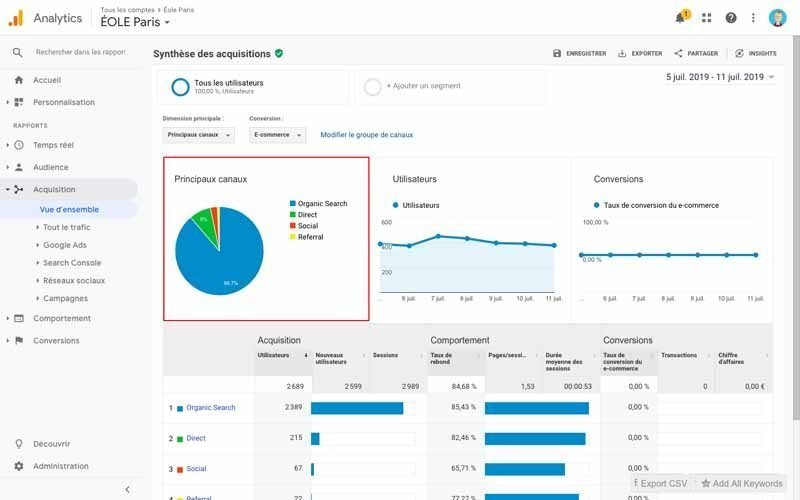
The word traffic in SEO refers to all visitors who visit a website. There are several types of traffic that are :
- Direct ;
- Organic ;
- Paid ;
- Referral ;
- Social ;
- Mail.
To track where your traffic is coming from install Google Analytics which will also show you other valuable information.
Direct traffic
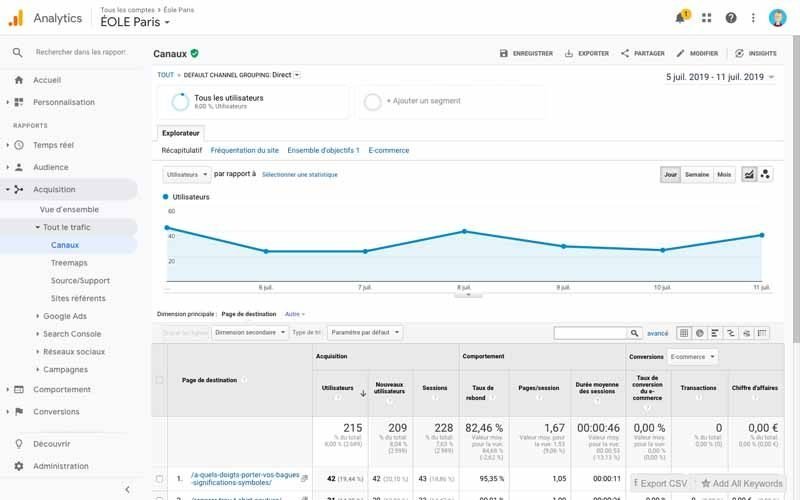
Direct traffic is traffic that lands on your website by typing your URL directly into a web browser. If you have ever landed on a website after typing its URL, you are part of the direct traffic for that website.
The only way to attract more direct traffic to your website is to make sure as many people as possible know about your website. Every email, social media post… that you send out should contain your website URL.
To do this, place your URL on:
- Your social media accounts;
- Your product packaging;
- Your business cards;
- Etc..
Email traffic
As the name suggests, email marketing traffic is the traffic that arrives on your website via the links contained in the marketing emails you send.
Email marketing has its own rules and practices practices that you should know.
Organic traffic

Organic traffic is when visitors land on your website through a search engine query. In order to get this type of traffic, you need to optimize your website by using several tactics such as positioning on keywords specific to your theme and products that you know your potential customers will search for.
Paid Traffic
Paid traffic refers to users who access your website through paid advertising on the Internet. Google AdWords is the most used platform for this, but there are also other options on other platforms such as Facebook, Yahoo, etc..
The success of this type of traffic depends on several factors and these five tips from Neil Patel will certainly help you.
Social Traffic
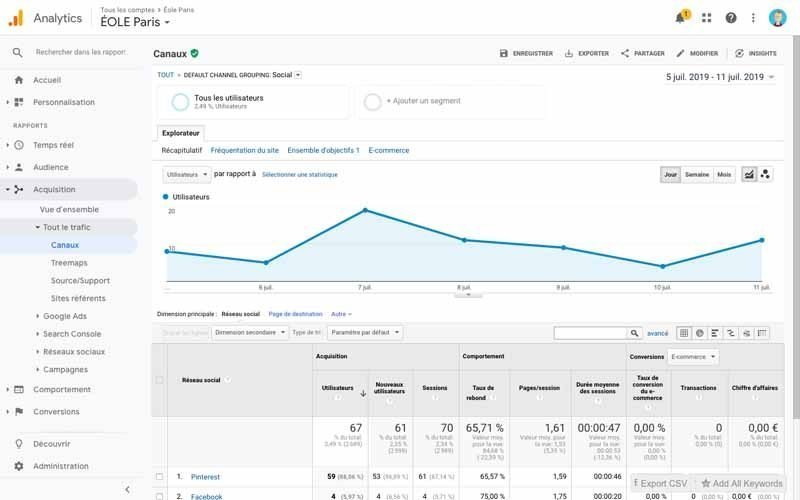
Social media traffic comes from your presence on social networks such as:
- Facebook;
- Twitter; ;
- YouTube;
- Instagram;
- Pinterest ;
- Etc..
Indeed, social traffic tends to start slowly, but it usually has a ”snowball” effect as you gain more followers. To succeed in generating social traffic, you must master one golden rule: Know your audience.
Social media is an opportunity for your business to humanize itself, so reach out to your customers, study them and post content/posts that you know they will enjoy and interact with.
Referral Traffic
Referral traffic is measured by users who access your website via external links clicked from other websites outside of search engines and social networks. Besides organic traffic, this is probably the best type of traffic to gain.
By creating quality, shareable content, you can gain a lot of backlinks, and therefore referral traffic, to your website. Just keep in mind that links from social media sites are not considered as backlinks by Google, and therefore will not impact your SEO ranking
Traffic potential or traffic potential
The traffic potential is a maximum estimate of the number of visits that a website can register in relation to the website in relation to the positioning on keywords.
U
Uniform Resource Locator or URL
The uniform resource locator is a unique text that the user fills in the bar of a browser to access a website, www.twaino.com is an example.
Generally, a URL is composed of 4 parts that are :
- The protocol ;
- The domain name ;
- The folder ;
- The page.
In terms of SEO, it is recommended to:
- Create readable and easily understandable URLs;
- Prefer hyphens to underscores;
- Create a simple and concise domain name to facilitate its memorization;
- Create a domain name that is as logical as possible and that translates all the content of the site into a few words;
- To insert keywords for a better indexation;
- Etc..
This resource from Neil Patel is likely to help you in the creation of your URLs.
Unique visit or unique visit
The unique visit in SEO refers to the very first time that a user consults and navigates on a website. Any other visitor accessing the website via the same IP address will no longer be considered in the list of unique visits.
URL parameter
The URL Parameter refers to the data dynamically added to the URL of a page after the request is executed.
Example: www.dynamicurl.com/query/thread.php?threadid=64&sort=date=64&sort=date
In the above example, the entire query string following the “?” sign is considered a URL parameter.
User engagement
This is a measure that allows to estimate the ability of a website to attract the attention of its visitors and encourage them to navigate on the site.
User experience
The user experience is a very important factor that allows search engines to rank the level of success of a website or a product. Generally, the user experience is influenced by :
- Simple, friendly and pleasant user interface ergonomics;
- The structure of the site;
- The loading speed of the website pages;
- The responsiveness with mobile devices;
- Etc..
This is a very important criteria in terms of SEO and you can measure the user experience of your website with these recommendations by Neil Patel.
User-friendly
Said of something that is easy to use.
User-generated content
User-generated content is any type of content posted by users. This can be comments, reviews, images, videos, social media posts and more.
The more user-generated content you have, the more important it is to your SEO. Moreover, it influences your success on social networks and it is wise to include it in a good SEO strategy.
User interface (UI) or User Interface
The user interface refers to all the content of your website that displays and interacts with your users. To attract more visitors, a user interface must be :
- Simple and devoid of any uselessness;
- Ergonomic and pleasant with a harmonious mix of colors and fonts; [merge_menu_anchor name=”V” class=”V”][/merge_menu_anchor];
- Consistent;
- Intuitive and anticipate the user’s needs;
- Etc..
The major goal of the user interface is to provide a good experience to the users.
V
Vertical search engine
These search engines have specialized functions and focus on specific portions to perform their searches. Google also has several search engines like:
- Google Maps ;
- YouTube ;
- Google News ;
- Google Images;
- Local search ;
- Etc..
Video optimization or video optimization
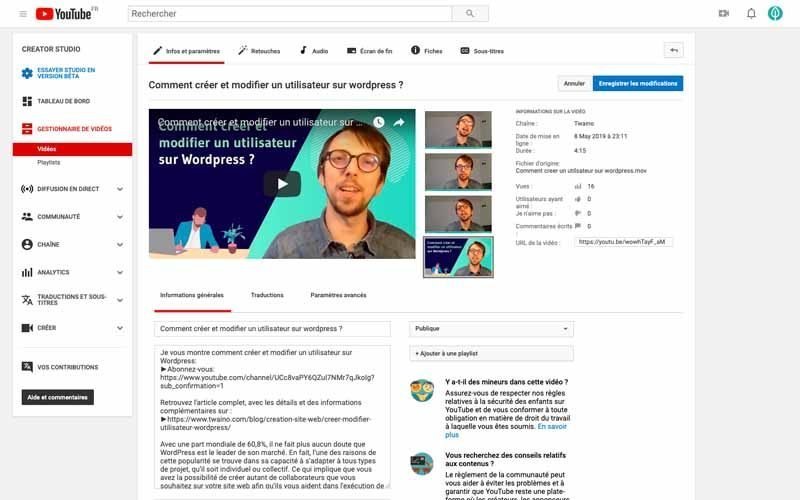
Video optimization is a procedure to boost the visibility of videos. This process is divided into two steps aimed at optimizing the channel and the video itself.
This practice includes actions such as:
- Keyword identification;
- Proper use of tags;
- Producing a description that is useful to both viewers and crawlers;
- Using thumbnails to allow search engines to quickly index the video among many others;
- Etc..
Indeed, 52% of consumers say that watching product videos makes them feel more comfortable about going ahead and making a purchase. It is therefore a real lever that it is very relevant to add to your strategy.
Viral content or viral content
A viral content is any media that reaches a popularity rate in a very short time. It can be an article, an image, a video or a tweet that spreads very quickly on the web via backlinks and social networks.
Visit or session
A visit refers to each time a user visits your website and spends time browsing it. It is counted, even with a former user as long as 30 minutes separate the visits.
W
Website or Web Site
According to Wikipediaa website: ” is a set of web pages and resources connected by hyperlinks, defined and accessible by a web address. A website is hosted on a web server that is accessible via the global internet, a local intranet or from the web server itself. All public websites constitute the World Wide Web. “
Website quality or quality of the website
The quality of a website is the set of criteria on which search engines base their ranking of this site. Here are some key elements that allow us to appreciate the quality of a website:
- Content Relevance;
- Content size;
- Visitor engagement;
- Social Signals;
- Backlink profile ;
- Readability;
- Media diversity (videos and images).
X
XML sitemap or XML site map
The XML sitemap is a file of type XML which gathers all the URLs of a Web site with some additional information called metadata. It reinforces the referencing because of its importance in the exploration and the indexation of the Web site.
There are several types of sitemaps that can be distinct or grouped in the same file. We have sitemaps :
- Image;
- Mobile;
- Video site ;
- Google News Sitemap;
- Site map hreflang.
Designing an XML sitemap can be done automatically and ready to use with some dedicated tools. Neil Pal teaches you how to create it in 20 seconds.
Y
Yahoo
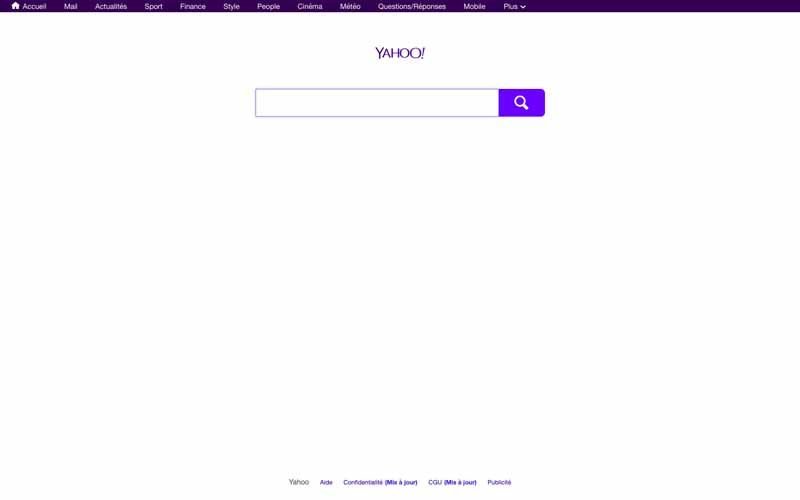
Yahoo was once the leader in email and search engine. As of April 2019, Yahoo has positioned itself at second place among search engines with a market share of 4.81%.
Yandex
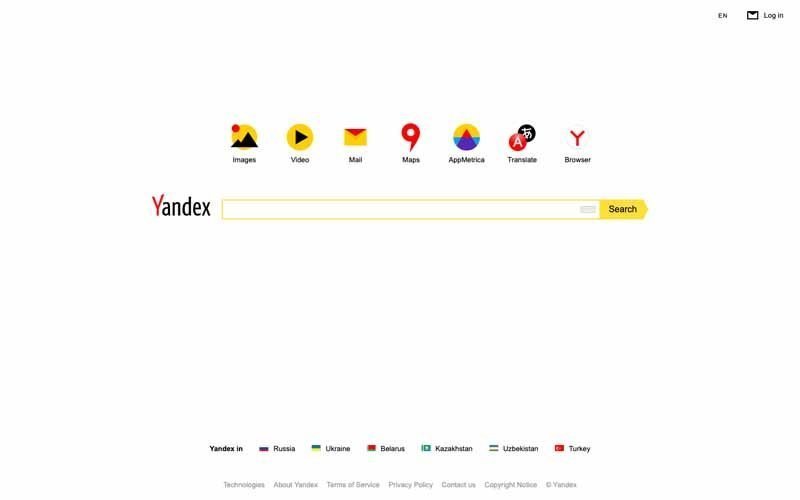
Yandex is the preferred search engine in Russia with a success of 49.39% in the Russian market and 0.58 globally.
Yandex offers results classified as geo-independent and geo-dependent. This policy of distinguishing results by region makes it easier to promote companies with .
YMYL pages
YMYL (Your Money or Your Life) is a Google search guide that offers diverse advice on :
- Finances ;
- Happiness; Health; ;
- Health ; Education ; Children
- Parenting;
- Nutrition;
- Etc..
These advices can affect the life of the Internet users in good or in bad depending on their veracity. Aware of this importance, Google remains very hard on the acceptance criteria of a YMYL page to protect its users.
YouTube
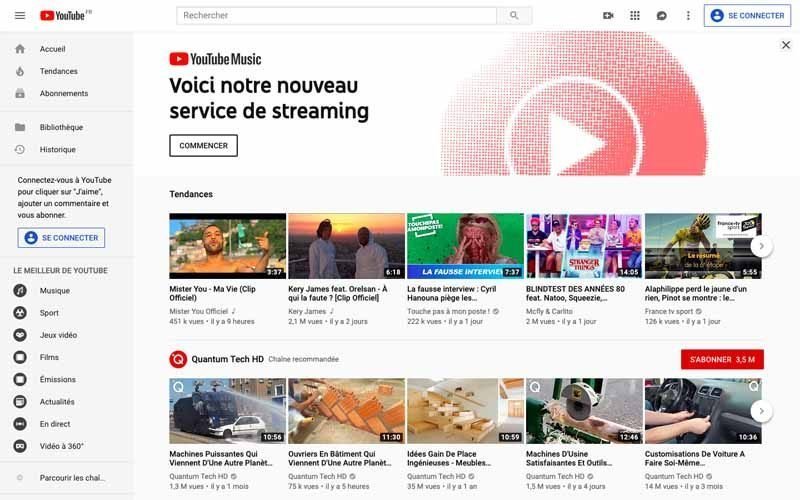
YouTube is the largest video sharing platform and the second most used search engine by Internet users in the world. The site currently has more than two billion monthly connected users.
It is also a real lever in terms of natural referencing, especially since YouTube videos have been appearing at the top of search results for several years. Here is a guide by Neil Patel which says a lot about the subject
Conclusion
The SEO is a very vast discipline with a very rich lexicon. While some expressions can be easily understood, others require further explanation. Moreover, the use of English sometimes complicates the task of those who are not very comfortable with this language. That said, it is important to become familiar with these terms if you want to use SEO as a strategy to gain visibility. This glossary aims to help anyone who wants to better understand SEO In addition to definitions, it also includes explanations and additional resources to go deeper into the subject if you wish. Also note that this glossary is likely to be regularly updated to integrate new expressions that will be created for this discipline.
See you soon.

